Maja Voje's Blog, page 4
April 25, 2025
From 0 to 250,000 Users Without Spending a Dime: Ajelix’s Bootstrapped AI Journey
Dear GTM Strategist!
I am a sucker for “winning against the odds” stories by small teams. If you share my passion for these heroic go-to-market endeavors, you will love this one.
Meet Ajelix, the easiest way to get expert-level analysis with AI that quietly scaled to 250,000 users without pouring cash into marketing. No VC dollars. No growth hacks. Just a relentless focus on solving real problems for spreadsheet-heavy teams and making the product ridiculously easy to discover and adopt.
The AI momentum surely helped, but this case study isn’t about hype.
It’s about the craft of aligning go-to-market elements (market, customer, product, positioning, pricing, and growth (GTM motion) into an exponential growth curve.
Agnese Jaunošāne, the co-founder of Ajelix, shares the unfiltered, behind-the-scenes story of how she and her team strategically rode the AI wave - leveraging SEO, user feedback loops, and building a powerful PLG motion to drive scale.
⭐ Bonus: at the end of the article, you will find her Zero-Budget GTM Checklist for AI SaaS.
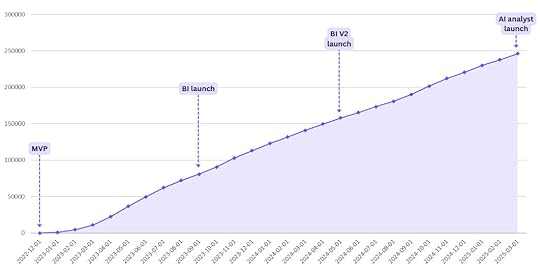 A snapshot of Ajelix’s 2.5-year bootstrapped journey to 250,000 users
A snapshot of Ajelix’s 2.5-year bootstrapped journey to 250,000 usersLet’s dive into what every founder and GTM strategist can learn from their story.
Disrupting a billion-dollar market of Excel-assisted productivity with AIWho runs the world? Excel.
The majority of businesses still rely on intelligence from spreadsheets to run their operations.
A painfully underserved submarket of this gigantic market is individuals who do not understand Excel and need a more user-friendly way to start harvesting insights from the oceans of data they have, but don’t know what to do with them.
And do not mistake this for a second as just an “SMB problem.” The larger the company, the greater the pain becomes. The Business Intelligence (BI) market is projected to have a CAGR of 8.9%. Choosing a subsegment of a healthy market with good future projection and a burning pain point surely sounds like a great place to win.
But there is a secret sauce to it - have a skin in the game.
Ajelix’s cofounder Artūrs Jaunošāns spent 10 years automating Excel and Google Sheets as a top Fiverr freelancer, building CRMs, dashboards, and custom workflows for clients worldwide. By the time Ajelix launched, he had solved thousands of real-world spreadsheet problems and knew precisely where users got stuck.
He always dreamt of creating a successful SaaS product.
But there was a missing link - some advancements in AI and his partner in life and business, Agnese 😉
 Agnese and Artūrs, founders of Ajelix
Agnese and Artūrs, founders of AjelixAgnese and Artūrs were newly married and both starting their MBA in 2022. For one subject, they had to create an export plan for a product. Piece of cake 🍰 for them, but seeing others struggle with it - it was a wake-up call that the time is right to go all in product.
They zeroed in on a common frustration they’d seen over and over: writing spreadsheet formulas. And when they discovered OpenAI in the early days, before ChatGPT was mainstream, the pieces finally clicked. AI would be the game-changer.
They went all-in on two macro trends:
The explosion of data analytics and
The coming wave of AI-powered tools.
In late 2022, Agnese and Artūrs launched Ajelix with a smart distribution play: a dedicated SEO landing page for every AI tool they built. Within a month, they had their first paying customer, without spending a cent on ads.
In the next section, we will dive into their winning Go-to-market Motions - but there is one more element you need to consider - their mindset:
For this power couple, building Ajelix wasn’t just about growth; it was about freedom. Remote-first, self-funded, and working toward a shared dream, they’ve built a business that fits their life, not the other way around.
Agnese and Artūrs now live in a small house in Italy's countryside that they are slowly renovating while managing their SaaS business. As they come from Latvia, having been used to flat landscapes and cold weather, Italy was a dream come true.
“We live near the Apennine mountains and we don't even have to change winter tires. We've been travelling a lot, and the biggest bonus of all of this is that we can spend time together and don't have to align with others' work schedules or try to get vacations approved from managers. We live in a small village and our neighbours still don't understand why we are in the house all the time, not driving to work,” says Agnese.
But let’s go back to how it started…
Winning Strategy: Build AI tools for most search terms and dominate SEO before it gets crowdedBack in 2022, Ajelix was early into AI for Excel game. Agnese explains: “Based on the Google Trends chart below, you can see that interest was initially low, and competition was almost nonexistent. As a result, we easily secured Google snippets and first positions for niche keywords. Considering that our website's Domain Rating (DR) back then was 0, it wouldn’t be impossible to compete with keywords that have big competition.”

Not surprisingly, inbound (with a focus on SEO) became the first strong growth channel for Ajelix.
How? Give the market the tools - not only SEO articles.
Search trends informed their product roadmap.
MVP launched with seven very simple AI tools.
Ajelix’s team identified search trends for spreadsheet-related problems and created AI solutions to match their needs.
The Excel formula generator became incredibly popular and was later widely copied. It reached 8.7K monthly search volume in April 2023, just for the keyword “Excel formula generator”, and got Ajelix around 11K new users.
The VBA script generator, which automated spreadsheet tasks, was another hit. The common goal of all these tools was to make working with spreadsheets easier.
“Our main acquisition channel from day 1 was SEO. We had a landing page for every tool that targeted keywords for (back then) non-existent niches,” explains Agnese.
They lead with a vision that AI is the future of “spreadsheet headaches”.
Following the launch of ChatGPT in late November 2022, these categories experienced a surge 🚀.
 Count of new users registering every monthRiding the AI Hype: 1000+ influencers posted about Ajelix for free
Count of new users registering every monthRiding the AI Hype: 1000+ influencers posted about Ajelix for freeAmazing SEO started to attract hundreds of users to Ajelix’s product every single day. The traction exploded. Before we dive into this further, let’s stress that this would not have been possible without a product that solves a real problem really well.
Product-led growth in full swing 👏 :
Let users “try before they buy” - offer freemium tools with a simple interface. Ajelix reduced friction by creating super easy & fast signup, no surveys, no credit cards, no trials.
Lower time-to-value: simple onboarding, reduced friction, and instant value
Implement fast feedback loops: make it effortless for users to share feedback, enabling the team to improve UX and resolve bugs in real-time rapidly. The best method for feedback collection is to implement it right inside the tool’s interface.
Usage-based expansion: people upgrade based on the received value. Ajelix had very clear limitations and upgrade paths from Day 1.
Strong SEO positioning and the surge in demand for AI solutions following the launch of ChatGPT were the tailwind for Ajelix’s growth.
Agnese explains: “Anyone looking to write about AI in spreadsheets would find our articles as a primary source. Everyone talked about "AI tools that are illegal to know". This resulted in more than a thousand articles, websites, listicles, postings, and videos. At some point, influencers began duplicating one another, so we are still featured in these posts after nearly 2 years.”
 Example of a HubSpot article mentioning Ajelix
Example of a HubSpot article mentioning AjelixI asked Agnese if she really hadn't paid some influencers to fuel the growth (I am a challenger 🤠). She answered:
“We spoke with some influencers, but paying for one post $3000 is not a viable option for a bootstrapped business, and it is hard to predict that the investment will add up. It’s like paying for ads; once you stop, there’s no traction. That’s why we chose the alternative route to build our community and create long-term traction.”
If you're new to AI or unsure how to fully get value out of it, you do not wanna miss out on this one. Attend the FREE webinar by Jonathan Kvarfordt (my go-to AI prompt strategist for GTM) and Jordan Nettles on May 6th.
In just 45 minutes, you will learn how to automate GTM execution and turn AI agents into actual team members. Plus, you will get 200+ usable prompts to take with you.
 Nothing lasts forever: From hyper-virality to building predictable and repetitive go-to-market motions
Nothing lasts forever: From hyper-virality to building predictable and repetitive go-to-market motionsYou and I both know what happens when something goes incredibly well: More competitors enter the space, established competitors start copying you, and the law of diminishing returns kicks in.
Regardless, Agnese advises not to underestimate SEO: “SEO is slow, but I’d say that ranking for low-competition keywords or fresh topics can be quite fast. The biggest bonus of SEO is that it works by itself. We have a blog with over 250+ articles. While I focus on other channels and test different approaches, SEO keeps bringing in users.
Yes, the last year has been pretty rough in terms of SEO with so many updates and AI overviews changing the user behavior, websites don’t get as many clicks as they used to. We’re also feeling this. But the good news is that the organic search traffic is differentiating, as we’re seeing more traffic from LLMs and Bing.”
Optimisation for LLMs (AI tools like ChatGPT) is still quite a black box, but, in Agnese’s experience, success lies in being featured on several sites and leveraging brand recognition on the web. For example, Ajelix is mentioned in several articles as one of the best "AI Excel tools." LLMs connect that information and showcase Ajelix as the top selection. LLMs are searching for validation, so your task is to make sure your brand is mentioned in several important places.
While Inbound (SEO - products, landing pages, and content) still brings in 80% of Ajelix’s users, Agnese and her team had to start developing other channels and Go-to-Market Motions.
 GTM motions that work for Ajelix
GTM motions that work for AjelixThey again went where the audience is - to communities such as Reddit, LinkedIn, and online forums. Agnese explains: “In the beginning, we didn’t use these platforms ourselves to get traffic. The buzz happened without our interaction.”
And they are trying to add more Inbound tactics. They are focusing on founder-led growth on LinkedIn, as well as YouTube videos and collaborations. Agnese notes that being active on LinkedIn helps her collect customer feedback and opens up new opportunities for collaboration with content creators.

This newsletter is sponsored by Icypeas.
Icypeas is a GTM tool to build your prospect lists and enrich leads with triple verified emails to protect your deliverability.
It is used by top-tier GTM products (Apollo, 6sense, Lemlist, Instantly, Phantombuster, etc.) and outbound agencies (ColdIQ, Growth Engine X, C17 Lab, Scalability, etc.).
CEO of Icypeas, Pierre Landoin, prepared a free step-by-step guide of how to:
✅ Discover 1,500–2,000 warm LinkedIn leads per day
✅ Find your best-fit ICPs based on automated filters
✅ Run this on autopilot (he shares exact tools and APIs they use)
Grab this workflow - it is exclusively available for readers of GTM Strategist:
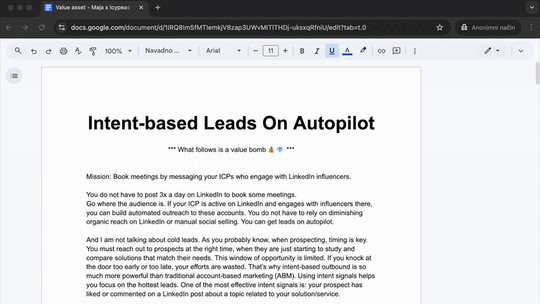
Hype brings some product-related and business challenges, too. Agnese lays them down:
“Scalability wasn't a problem, thanks to my co-founder's foresight in product development. We were able to upgrade our system smoothly as demand grew. Our real struggle was with email deliverability. Transactional emails consistently ended up in the spam folder, which was a major headache. Imagine a user trying to register and never receiving a confirmation email! It took us months to finally solve this, but we've got it under control now.
The other ongoing challenge is the freemium plan. Though it fueled our initial virality and growth, converting users who came with no intention of paying is difficult. They often create multiple accounts to prolong their access to freemium features, avoiding payment altogether.”
And guess what - your work on “Personas” (ICP) is never over. When the market changes and the product becomes better, it is time to revisit them.
“As time has passed, the user personas we thought we had are no longer relevant. We’re actively working on this together with a mentor, we’re going back to basics by actively trying to define the “BIG problem” we’re solving and drafting user personas,” explains Agnese.
The vision of “organic only” can take you far“When we launched Ajelix, we agreed that we would use only organic channels. Because we wanted to build a system, not a one-day tool. It all depends on your mindset. There are so many ways you can grow a product without paid ads, like collaborations, partnerships, integrations, content, founder-led growth, forums, and others,” says Agnese.
She prepared a ✅ checklist on how AI SaaS products can grow without a budget:
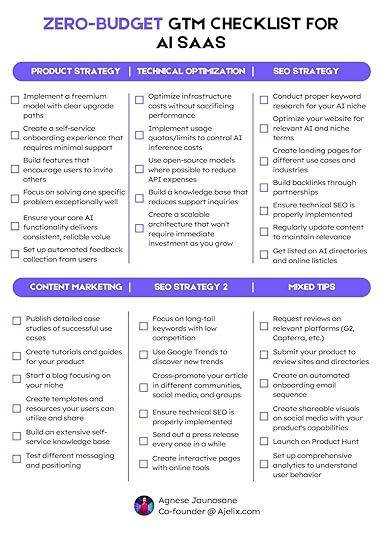
She used it for their new launch:
“We’ve captured new demand and just launched a chatbot, but for data tasks. We have a live chat on our portal, and for several months, people wrote to us thinking I was an AI assistant who could analyze their data from conversations. So, we finally decided to launch a chat specifically for analysis tasks. We created sketches in Figma and conducted a survey asking for feedback on whether people would use this tool and what features they would need. We received over 300 responses and comments, with 74% indicating they would use the tool every day.
I’m super excited because people have been asking for this a long time, and it can do pretty insane things. From data cleaning to report generation in different formats.”
You can check it out at https://ajelix.com/tools/ai-data-analyst/ and stay in touch with Agnese on LinkedIn if you want to keep track of their progress.
The reason why I invited you to think about this story is to empower you, firstly - you do not have to break the bank or have 50 people in marketing to launch something successfully. Ajelix is a team of two (now three - they added a junior marketer in 2025). Work with what you have and make the best out of it.
For those few readers who have experienced hyper-demand before:
You have to do whatever it takes to catch up with demand (it is very nerve-wracking) - but please know that eventually the momentum dies off and you need to have another ace in your sleeve.
A good product and the right momentum can go far - ride the wave, but be ready that nothing lasts forever and prepare to spend at least 10-20% of your marketing resources testing new channels.
However, solid GTM fundamentals are mission-critical for building a sustainable business for both AI and non-AI products and services.
If you want to learn more about GTM fundamentals, seek no further than my GTM Checklist with AI prompts. It includes 100+ steps to guide your go-to-market strategy, including examples, templates and frameworks.
Agnese used the template to collect reviews and it worked well for her.

April 18, 2025
LinkedIn Mega Moodboard: 3073 Posts Analyzed From 30 Purposefully Selected Creators
Dear GTM Strategist!
Every quarter, I analyze my list of 20-50 content creators to derive my insights for what is expected to work on LinkedIn, and this time, I want to share the most important insights from my analysis with you.
[image error]This analysis takes approximately 14 days to conduct. I spend the most time analysing the posts and trying to learn from them. I have tried AI-enabled analysis, but it has limited cognition in image analysis, and I learn more if I stare at those posts, trying to figure out what’s in it for me.
If you are thinking - “Maja, how on earth do you get time to do this?” - the answer is: because it matters to me.
Why:
LinkedIn's algo is changing all the time, and you and I have to keep on top.
I read general LinkedIn algorithm studies, and they are great for a general understanding of what is going on, but lack tactical insights for my specific vertical.
Some hard NOs for me on LinkedIn - overrevealing personal life, trash motivation posts, vanilla general knowledge carousels - are non-negotiables. I have to learn from creators who create knowledge.
Many creators use engagement pods and bot likes - I have to control the sample.
Method of collecting and analysing data:
I go through all my saved posts on LinkedIn.
If I saved 3+ posts from a creator, I include them in the analysis.
I monitor some creators regularly because they are really, really good, and I learn from them non-stop (about 20% of my observed sample).
Is the sample biased? Of course it is - because I curated it. I encourage you to run this analysis on your selected profiles.
I run my scripts to collect all the data.
I run some joint analysis - general trends.
I spend a lot of time learning from the board.
In this Substack, I will share a couple of lessons learned:
Best-performing formats of LinkedIn posts
When to post
How often to post
What topics work best
What are my bets in Q2 2025
Let's dive straight into whether that sounds like a good use of your time and bandwidth.

This newsletter is sponsored by Icypeas.
With Icypeas, you can scrape leads from Sales Navigator. The free plan allows you to scrape up to 1,000 leads per day!
Watch this 60-sec demo:
Get 500 Icypeas credits for free by signing up using the link below!
Single image + long-form text is still a winning formatWhile the guru advice is “play around with different content formats,” I have solid data that “single image + long-form text” is a go-to format for most of the analyzed profiles. The rising formats are video (22.0%) and text only (18.6%). Other formats are marginal.
What I found surprising (and made me quite happy because that is lots of work) is that there were zero carousels (documents) among the best-performing posts from 30 content creators in the sample. While some LinkedIn advisors still rave about carousels, I think Canva AI ruined it for us :) - based on the number of really shallow carousels I have detected on my feed.
 50% of analyzed LinkedIn posts have a single imageWhen to post: 2 daily spikes and TUE-THU safe zone
50% of analyzed LinkedIn posts have a single imageWhen to post: 2 daily spikes and TUE-THU safe zoneBased on cumulative posting patterns, the best time to post for the main US audience is at 2 pm GMT. Please note that nearly all the analyzed profiles are based in the US and Europe when you try to make sense of this data.
 Two peaks: at 7 am and 2 pm GTM
Two peaks: at 7 am and 2 pm GTMFor example, if you are from the US, the best time to post is in the morning.
Based on the best days to post, anything apart from Monday, Friday, and Saturday is expected to do well.
 I wrote more about content creation for LinkedIn in this post
I wrote more about content creation for LinkedIn in this post It’s interesting that when I work with brands, they require content creators to post between Tuesday and Thursday. Seems to be a safe zone.
Once you have your list of LinkedIn influencers to analyse, you can use Pierre Landoin’s tactic to get emails of people who engaged with their posts and send email messages to them to book demos.
CEO of Icypeas, Pierre Landoin, prepared a free step-by-step guide for discovering 1,500–2,000 warm LinkedIn leads per day, finding your best-fit ICPs based on an automated filter, and running this on autopilot (he shares exact tools and APIs they use).
Grab this workflow - it is exclusively available for readers of GTM Strategist:
How often to post? Up to 18x a week if you ask some people 😺But the average is about 5x a week. In my sample, you can observe two schools of LinkedIn posting:
Focus on quality posts 2-5 times a week - do less, do it better.
Go all in - 2x a day is a minimum.
I was trying the second strategy for a couple of weeks. I posted in my morning and late afternoon. The results did not justify the investment of my time (another hour spent on LinkedIn), so I am back to 5 posts a week for the foreseeable future.

Please note that the majority of these profiles have 30K-250K followers. I did not include smaller creators in this analysis.
What topics worked best for this batch of creatorsLong story short, 5 topics that pop up again and again are:
Millions and billions + famous brands #greed
How to do X using Y (without Z) #tutorial
Simple visualisations of complex topics #education
Anti-mainstream content (VC, AI, small teams, bootstrapping) #contrarian
Personal updates and milestones #humanizations
What worked predictably well in my sample was AI-related content (tool updates), agents, weirdly popular MCPs, and mentioning numbers in the hook, very long but easy to read (lots of whitespace) essays, and tutorials on how to do something using AI.
Here are some outliers from the batch of analysed posts that did exceptionally well, even from smaller creators:
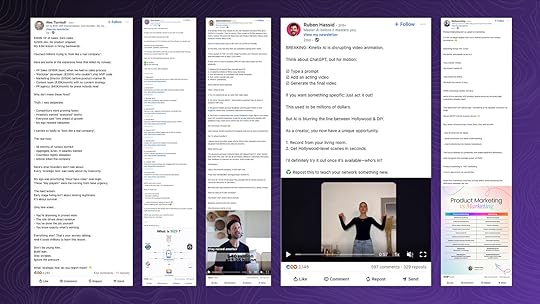 How will I apply these learnings to my LinkedIn strategy
How will I apply these learnings to my LinkedIn strategyGosh, that was fun to analyse! I would love to say to myself: Spend more time on creating great content, work relentlessly to keep up, unlock new winning format - but I will not :)
Realistically, given all my other business obligations, I know how much time I can spend on LinkedIn and when I have a negative ROI.
Most of the analyzed profiles have content teams and $5K-15/month content strategists who spend a significant share of their week creating content. That is the cost I am not willing to pay now, and I can spend up to 1 hour a day (preferably less) on LinkedIn during my busiest time of the year.
Here is what I am gonna do instead:
I will feed some of these posts to my AI model
Come up with a list of topics I want to talk about
Create an AI-assisted workflow for creating content; and
Double down on my personal business experiences and tutorials on how to build things.
Something else struck me while observing this dataset: Reposts will have lower engagements per se, but they are a powerful tool for supporting other content creators and pushing your colleagues' content - this is something I will try.
11 out of 30 analysed content creators did not repost content, but those that did set aside up to 10% of their posts for reposting. This is something that I might add to my mix.
 Percentage of reposted content by profile
Percentage of reposted content by profileThe entire board is available to my consulting clients (+ I create custom boards for them based on their relevant LinkedIn influencers) and has just become part of my GTM Checklist with 100+ assets, examples, templates, and prompts will power up your GTM strategy.
If you already have the checklist, just check line 99 in your spreadsheet (task: Publish 1-3 updates a week on social media to warm up for the launch) - you have an update there, as well as some helpful prompts for content creation that will get you started.
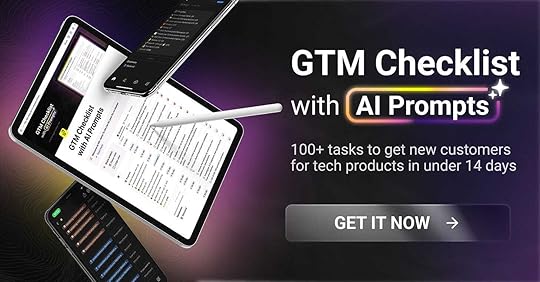
April 11, 2025
5 AI Use Cases for GTM Market Research
Dear GTM Strategist,
Abraham Lincoln said, “If I had eight hours to chop down a tree, I'd spend six hours sharpening my axe.”
Good preparation is a key to success. The preparation for the go-to-market strategy starts with market research - collecting good intelligence for decision making (competitors, market, customers). And market research should not be limited to the preparation stage. It should be a regular activity and something that you regularly block time to do.
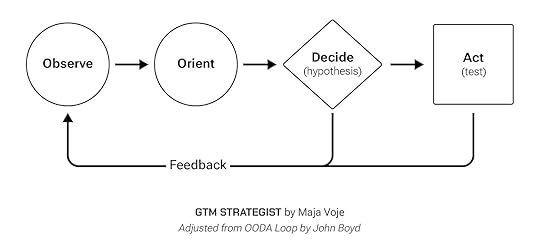 I devoted a whole chapter to knowing your market in my book Go-To-Market Strategist.
I devoted a whole chapter to knowing your market in my book Go-To-Market Strategist.Another military strategy comes into play. The OODA Loop is a mental model created by the U.S. Air Force Colonel John Boyd. It’s a practical concept and the basis for logical thinking in complex or chaotic circumstances. It consists of four stages: Observe, Orient, Decide, and Act, collectively known as the OODA loop.
And then came AI and changed everything.
Both ChatGPT and Gemini now have “deep research” mode, which can do in-depth analysis with lots of variables.
You can upload complete documents to AI tools to analyze large amounts of unstructured data.
AI is becoming more integrated with other software we regularly use. Emerging standards like MCP will make that even more powerful.
The basic principles remain the same, but tools and workflows are changing and access to intelligence is easier than ever. Having unique insights is still a massive advantage, but the grunt research work can be beautifully optimized.
In this newsletter, I am sharing my best practices and use cases that will help you gain intelligence faster. We will cover:
Best practices, prompts, and tools for market research in GTM
How AI can make you 10x more productive
5 hands-on use cases

This newsletter is sponsored by Icypeas.
Icypeas is a GTM tool to build your prospect lists and enrich leads with triple verified emails to protect your deliverability.
It is used by top-tier GTM products (Apollo, 6sense, Lemlist, Instantly, Phantombuster, etc.) and outbound agencies (ColdIQ, Growth Engine X, C17 Lab, Scalability, etc.).
CEO of Icypeas, Pierre Landoin, prepared a free step-by-step guide of how to:
✅ Discover 1,500–2,000 warm LinkedIn leads per day
✅ Find your best-fit ICPs based on automated filters
✅ Run this on autopilot (he shares exact tools and APIs they use)
Grab this workflow - it is exclusively available for readers of GTM Strategist:
 Best practices of market research for GTM
Best practices of market research for GTMMost GTM teams make one of two mistakes:
They skip research altogether because “they know better”.
They go down a rabbit hole of competitor analysis and never ship anything. There’s a term for that: analysis paralysis.
They might think that you need a large budget to do market research.
But all you need is intellectual curiosity, structured thinking - and now a bit of AI assistance. With smart workflows, you can now do more insightful, more iterative, and faster research than ever before.
First, let’s tackle the key information you should gather in the initial stages.
The first question should be: Is this a market worth winning?
One effective method is analyzing the Total Addressable Market (TAM), Serviceable Available Market (SAM), and Serviceable Obtainable Market (SOM).
TAM represents the total demand for a product or service.
SAM is the segment targeted by your products and services within geographical reach.
SOM is the portion of the market that your company can realistically capture, considering the existing competition and market entry barriers.
But you don’t need to bother with definitions. Just ask your AI assistant to perform the research and give you the estimates. You will find the prompt example in the next section.
Next question: Who are your competitors? They are playing to win, so you better analyze what they're doing.
Here’s another trap that often leads to wasting precious time: in-depth analysis of every potential competitor in a crowded market. Up to 10 will be more than enough. If your target market has only 2-3 competitors, that is enough to start with. Rather, think of indirect competitors - what are your potential customers currently doing instead of using your solution? Sometimes, the answer will be “Excel sheet” or “nothing”.
Here are my proven steps for competitor analysis:
1. DIY customer research:
Talk to your customers or prospects. Find out which competitors they considered before choosing you, what the actual problems are they have, and how they are currently solving them.
2. Analyze the online presence of your competitors:
Do a teardown of their websites. Look at messaging, pricing, and sales funnels. Tools like SimilarWeb and BuiltWith provide insights into their tech stack and traffic on the website.
3. Marketing & sales activities:
Create a swipe file with their examples. This file will later come in handy for AI analysis of the key patterns and trends. Use SEO tools (Ahrefs, Semrush), social media monitoring (Brand24, BuzzSumo), and ad spy tools (SpyFu, Google Ads library). Tools like Brand24 enable alerts that can keep you updated.
4. Hands-on experience:
Engage with competitors directly. Make a purchase, a sales call, or hire a mystery shopper. Stay ethical while you are doing this, but it can be eye-opening to get the first-hand experience.
5. Netnography:
Look at online groups and review sites. See if there is some recurring feedback. You can check G2, TrustRadius, and others in B2B, or Amazon and forums in B2C. Then upload this to your AI tool to get insights much faster. You will find another prompt in the final section of this post.

This type of research will enable you to go beyond basic metrics like employee count or social media followers and focus on aspects that truly impact your buyer's decision.
Identify what truly matters to your customers - "free trial," "sustainability," or "quality of customer care" can all be crucial factors. These insights will guide your differentiation, positioning, and messaging, which are all essential elements of your GTM strategy. (I wrote more about positioning in this article).
Now that we have covered the initial market research questions, let’s see how we can achieve even more with the latest tools.
How AI can make you 10x more productiveMarket research might not cost you dollars, but it’s still expensive in terms of the time you can devote to it. It requires not only gathering lots of data, but also analysing and structuring it into meaningful insights.
Here is where AI tools and assistants can help most. It’s actually one of my best use cases for using AI. Think of it as having a junior research assistant at your disposal.
“10x more productive” is not an exaggeration in this case. You can easily lose 10 hours of information gathering if you are comparing several competitors and are diving into customer reviews. With smart use of AI, you can get powerful insights in less than an hour.
Here are my best practices for using AI for market research:
Combine AI tools with source uploads
When you have specific sources (PDFs, Excel, review dumps, strategy docs), upload them and ask:
“Analyze this document and extract key insights about GTM motions, ICP targeting, and feature priorities.”
You can upload G2 reviews, internal sales notes, even product pages. Let ChatGPT, Claude, or your tool of preference synthesize it all. This will turn unstructured input into structured intelligence.
 For larger projects, I open a new Project in ChatGPT, upload all relevant files, and then work there.
For larger projects, I open a new Project in ChatGPT, upload all relevant files, and then work there.Use AI assistants that can browse the web
Perplexity is one of my top choices. It has a powerful combination of web search and AI tools that is just natural for research. Now it also enables “deep research” mode.
Here is the prompt I use:
"Act as a market analyst. Provide a detailed overview of the [industry or product category] market, including: (1) the estimated Total Addressable Market (TAM) globally and by region, (2) key growth trends and forecasts, (3) major customer segments, and (4) a competitive landscape analysis identifying leading players, their market share, value propositions, pricing models, and go-to-market strategies. Include data sources and mention any recent developments or disruptive startups in this space."
Ask AI to follow specific frameworks and models
Again, think of AI as a junior assistant. It can process large amounts of information, but the results are as good as the instructions you give. So, one of the best ways is to instruct them to follow proven frameworks and mental models.
SWOT, for example, is a timeless, always useful framework to identify the strengths and weaknesses of your product (internal capabilities) and threats and opportunities on the market (external factors). For example, after feeding your AI tool documents with your product descriptions and getting initial market research, ask it to perform a SWOT analysis.
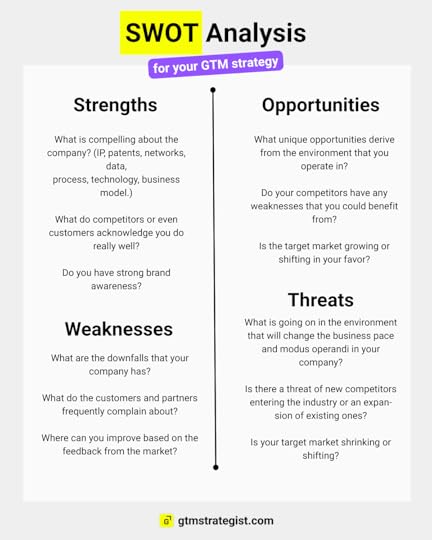 Example of some questions to guide your SWOT analysis
Example of some questions to guide your SWOT analysisUse built-in AI tools
Chat was the first “killer app” and interface of the generative AI tools. But now that they are getting more capable, make use of advanced integrations that are purpose-built for specific workflows.
If you use Google Workspace and have access to Gemini, it has become powerful to summarize long documents and give you actionable insights. So you can even skip document upload.
Even more specific examples are built-in AI features in tools like Miro. Miro recently launched AI sidekicks which were developed with partners such as Product Marketing Alliance. They are based on specific knowledge that makes them act like an actual person would review your plans.
 Example of AI sidekicks in Miro that give you actionable ideas for further research. See it in action.5 Hands-On Use Cases
Example of AI sidekicks in Miro that give you actionable ideas for further research. See it in action.5 Hands-On Use CasesTo make this quick guide even more actionable, here are five examples of how to rock your market research with AI to uncover new insights and stay ahead of the game.
1) Market Landscape ScanWhen I’m entering a new space, I ask my AI assistant to:
Summarize the current competitive landscape
Identify top players
Highlight recent shifts in customer behavior or regulation
List common buying criteria
It gives me a high-level map that I then cross-check with tools like SimilarWeb, G2 reviews, or market reports.
Prompt example:
“Act like a GTM strategist. I’m building a [category] product for [ICP]. What are the top 5 trends, key competitors, and customer frustrations in this market?”
2) Validate assumptions with AI-simulated customer interviewsYou don’t need 20 interviews to test your initial assumptions. You need 3-5 smart hypotheses and quick directional feedback.
I feed ChatGPT the profile of my ECP and ask it to simulate interview responses - based on public data, common objections, and review mining.
It’s not a replacement for real interviews. But it’s a great tool for pre-validating your assumptions and writing better interview scripts.
Prompt example:
“My early adopters are [describe persona]. Pretend you are one of them. What would you say in a customer discovery interview about your current solutions and frustrations?” [alternatively, conduct an example of a customer interview with consecutive questions - and your AI assistant acting as an early adopter.”
3) Automate competitive analysis teardownAnalyzing competitors used to take days. Now, I feed my AI assistant transcripts from websites, landing pages, even LinkedIn content - and ask for:
Pricing models
Feature gaps
UVP breakdowns
Go-to-market strategies
This is gold when you’re defining your own differentiation and choosing which “battle to win.”
Simple prompt example:
“Analyze this landing page and summarize its target audience, positioning, CTA, and offer hierarchy.”
4) Source qualitative insights at scaleNetnography - aka structured research on forums, social media, and reviews - is a dream when combined with AI.
You can scrape reviews from G2 or similar websites, then feed them to AI to cluster user sentiment and identify unmet needs.
Sometimes, a goldmine can be Reddit. Subreddits can reveal lots of customer sentiment you didn’t know existed and new perceptions of the product.
Prompt example:
“Summarize 100 G2 reviews of [competitor] into themes: top likes, dislikes, and feature requests. Prioritize by frequency.”
5) Deep researchDeep research is an excellent new feature in ChatGPT, Gemini, and Perplexity. Take some more time to write a prompt, outline your goals and expectations, preferably also the structure you want for the report. Your AI tool will research the web and synthesise the analysis for you. If your instructions are unclear, it will guide you with subquestions before finalizing the research.
 Select “Deep research” mode in ChatGPT to guide you with your research
Select “Deep research” mode in ChatGPT to guide you with your researchPrompt example:
"Act as a senior market research analyst. I want to evaluate the market opportunity for [PRODUCT / INDUSTRY]. Please conduct a deep analysis and return a structured report with the following sections:
Market Overview
Define the industry
Key trends and growth drivers
Size of the market (TAM, SAM, SOM if available)
Target Customer Segments
Main personas or buyer profiles
Key pain points
Current alternatives / existing behavior
Competitive Landscape
Top 5-10 direct competitors (brief descriptions)
Pricing models
Unique value propositions (UVPs)
Strengths and weaknesses
Emerging Opportunities or Gaps
Under-served niches
Innovation whitespace
Regulatory or technological tailwinds
Sources
List all used sources with URLs if available
Format the answer as a structured market research report. Use bullet points, bolded section titles, and include estimates with dates wherever possible. Focus on strategic insights for a go-to-market decision."
6) Build a living swipe file or moodboardSave all insights in Notion, Google Drive, Miro board, or similar. Return to them each quarter and upload them to your AI assistant to uncover more insights. Market signals change fast, so you should always stay on top of your research and monitoring game.
 This is an example of how I save the best-performing posts from top content creators to my moodboard
This is an example of how I save the best-performing posts from top content creators to my moodboardYou can get proven templates, examples, and more detailed prompts, including how to do market research, in my 100+ Step GTM Checklist.
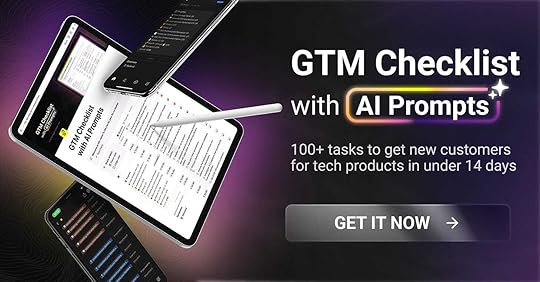
April 4, 2025
Use Social Proof To Elevate Your GTM Efforts
Dear GTM Strategist!
Social proof is becoming a norm on landing pages, sales decks, ads, and other marketing and sales materials in B2B. When we’re talking about social proof, it means that in addition to us saying that we are great, we have other people saying that too. We can show some numbers, photos, or videos - and that makes our “we are great” statement much more credible than if we are praising ourselves.
Still, many people do it in a vague and non-credible manner and are wasting tons of time and resources to produce vanilla social proof.
Hi Joe ⭐⭐⭐⭐⭐ , CEO who thinks your software is excellent. 👋
Most ICPs will not be convinced by Darren’s testimonial.
They are browsing your website to grasp answers to mission-critical questions in their purchasing cycle, such as:
What is it?
Should I care about it?
How is it better than existing alternatives?
Will it work for me?
Can I trust it?
They want much more solid evidence than “game-changing” by CEO Darren.
Let’s do better!
[image error]This newsletter is sponsored by Icypeas.
Icypeas is a GTM tool to build your prospect lists and enrich leads with triple verified emails to protect your deliverability.
It is used by top-tier GTM products (Apollo, 6sense, Lemlist, Instantly, Phantombuster, etc.) and outbound agencies (ColdIQ, Growth Engine X, C17 Lab, Scalability, etc.).
Get 500 Icypeas credits for free by signing up using the link below!
Meet my brother Jure Knehtl. I learned so much from him about Meta ads and ecommerce that I must pay him a special tribute this time. Since 2019, he demonstrated that User-Generated Content (UGC) outperforms all other ad creatives at his $60 million a year ad spend. In his career, he generated $200 million in ecommerce revenue, built two studios for recording ads, creatives and scaled three brands to $40-100 million in 2 years with this approach.
Then came AI: Jasper, CreativeOS, ElevenLabs, Synthesia, and now even ChatGPT’s own new image generation…. and changed how UGC is created.
 All these ad creatives are “fakes” - aka AI-generated.
All these ad creatives are “fakes” - aka AI-generated.While images with product fakes and photoshopped “people” could fool me any day, videos are still a bit robotic 🤖. But we are maybe a quarter or two away from mainstream dirt-cheap tools to solve this last frontier of faking user-generated products with AI.
Fun fact: More and more music on Spotify might be AI-generated - a smart move for saving on copyright.
I have been using AI for Meta ads - not to fake humans, but to test different voices in video ads, and it definitely sounded better than me reading the script. 🤠
With recent developments in AI image generation, the authenticity of your social proof materials is more important than ever. While I envision we will have a trust shield for “human-generated content” in the future, let’s dive into how we can leverage our GTM efforts by building more trust.
This is why I prepared this quick guide on generating social proof for your marketing and sales GTM materials that is authentic, verifiable, and effective. We will dive into:
7 Priciples of Persuasion
15 B2B social proof formats
Why scrappy is the new authentic, and
How to build a system for generating social proof at scale.
By the end of the article, you will get at least three ideas on how to build more trust, credibility, and preference for your products and services using social proof. And my bet is that it will help with your conversion rates.
7 Principles of Persuasion by Robert B. CialdiniBased on the definition of psychology today, trust is a key element of social relationships and a foundation for cooperation. It refers to a belief that someone or something can be relied on to do what they say they will.
How can we develop trust when transacting with strangers on the internet?
My go-to mental model, which I have been using since 2017, is Robert B. Cialdini’s principles of persuasion, which influence our behaviour and decision-making. They are widely used in conversion rate optimization, marketing, and sales.
Cialdini defined 7 principles :
Reciprocity: People feel obligated to repay favors and return kindness. When someone gives you something, you are more likely to give something back in return. Examples: gifts, lead magnets.
Commitment and Consistency: People honor their commitments and act consistently with their values and self-image. Once they commit to something, they are more likely to follow through with it. Examples: Upgrades on the cart and post-purchase upsells.
Consensus (Social Proof): This principle suggests that people are more likely to adopt a behavior if they see others doing it. Example: “8000+ businesses used the GTM Strategist methodology” makes me more credible than “Hi, I am Maja from Slovenia and I love GTM. 🤦”
Authority: People are more likely to follow the advice of an authority figure. Authority can be established through credentials, expertise, or social status. Example: To all landing pages, I add customer reviews as well as field experts' reviews, VCs and larger companies - I call this one white robe effect 🥼- doctor recommend.
Liking: People are more likely to be influenced by someone they like. This can be due to physical attractiveness, similarity, or other factors that create a positive impression. Example: I was resisting sharing personal updates on LinkedIn for a very long time, but when I tested some videos, I got disproportionally more reactions. It makes me think that you like me more if I show my human side. 🫶
Scarcity: This principle states that people place a higher value on things that are scarce. When something is limited in availability, people are more likely to want it. Example: All my sales promotions have a countdown (limited time only) and I do not take more than 5 consulting clients per quarter.
Unity: The seventh principle emphasizes the power of shared identity and belonging. People are more likely to be influenced when they feel a sense of unity or shared identity with others. This goes beyond superficial similarities and involves deeper connections based on shared values, affiliations, or experiences. Example: When I tell you that I am from Europe where there is more likely that you will see a deer 🦌 than an investor and more likely than not, you will have to bootstrap - that makes the GTM Strategist method more interesting for companies who know that they should do “more with less”.

Next, we will apply these principles and build you a checklist for social-proofing your products or services to make sure that your marketing and sales materials win the hearts and minds of your ICP. Principle #7 = Create Unity. 🤝
First rule of Social Proof - The more specific (and difficult to fake) the better!Great product!
Lost 10 lbs by drinking soap water every morning.
5/5 - I recommend!
Excellent team!
That is rubbish.
Non-specific, not relatable, or even bought/faked?
Let’s first develop a great taste for social proof pieces that will be so intuitive to you. A great social proof piece should include:
Proof of purchase/usage (screenshot or buyer verification)
Specifics of usage experiences
Results achieved - preferably with numbers
Verifiable reviewers data
Enough company and usage specific that it looks relatable to a viewer
A photo or a video of a person to make it more personal
Just remember how you would choose a restaurant from Tripadvisor, Yelp or Google Maps. You would seek restaurants with thousands of reviews and in the range from 4.1 to 4.7- because 5/5 with 6 reviews looks like a scam or food poisoning.
The same set of brains makes decisions for B2B purchases.
I created this rating of social proof elements that we often use in B2B. I scored it based on credibility (trustworthiness) and “difficulty to fake” (authenticity), and added examples of companies that use that effectively.
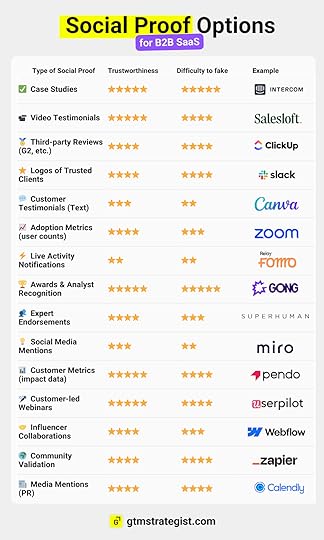
Next, I will point out some excellent pieces of B2B social proof from my clients and partners from which you can take massive inspiration. On average, highly converting SaaS landing pages include 7-21 pieces of social proof by my count.
Here are four quick breakdowns of the landing pages from Clay, Amplitude, Momentum AI and Miro - some great design trends there!
 See the breakdown with my comments at https://miro.com/app/board/uXjVII8RyEM=/
See the breakdown with my comments at https://miro.com/app/board/uXjVII8RyEM=/In addition to landing pages, you can use social proof practically in all marketing and sales materials - for LinkedIn posts and profile elements, sales decks, one pagers - you name it.
One more thing - highly produced materials look beautiful, but scrappy is the new credible.
You can score big time if you just share screenshots in your communication - like I did in my offer for workshops. Sorry, but if a client publishes something spontaneously on LinkedIn, that is 10 times more credible than all “rate us on (whatever platform) and have a chance to win a $50 gift card” that I have gotten.
 Lots of customer testimonials in my offers
Lots of customer testimonials in my offersThe next question is how to get tactical about it.
Build a system to generate social proofIn Q1, one of my key KPIs would become # of testimonials generated. Why? Because I need that for my websites, advertising materials (UGC still works great), and it makes me incredibly happy whenever I hear back from you 💌.
My reviews and testimonials were scattered around the platforms (LinkedIn, email, Amazon, WhatsApp) and for the longest time ever, I did not have a centralized system to capture all the good vibes.
Enough was enough, so I built this form in Notion where I collect reviews.
 My form for collecting customer testimonials
My form for collecting customer testimonialsIf you have not rated my products yet, I kindly invite you to do it here.
I have this link bookmarked and every time someone sends me some feedback, I ask them if they can pitch it. I also added this link to post-purchase sequences and I measure the number of reviews received as one of my weekly KPIs. After a while, I could create my very own Wall of love. ♥️
 We launched that last week: https://gtmstrategist.com/wall-of-love - if you want to be a part of it, you know what to do :) (hint)
We launched that last week: https://gtmstrategist.com/wall-of-love - if you want to be a part of it, you know what to do :) (hint)Now what is really important for me is that these systems are kind of automated, so I do not distract my deep work every time I want to add a testimonial. This is how I solved my “single source of truth” social proof problem. I send a link to my testimonials form in my post-purchase sequences, too.
If you are doing this for a software, definitely consider adding the request for reviews to your drip campaigns too. Make sure you keep all the testimonials in a single space. How about if you already have a lot of users and would like to get some social proof from them?
Agnese, cofounder of Ajelix, data analytics platform with 200K+ users (see what social proof is doing to your perception of the importance of this company 🤠) used my before-during-after testimonial framework to send out testimonial requests to the 1000 most active users and asked them to review the tool at Trustpilot.
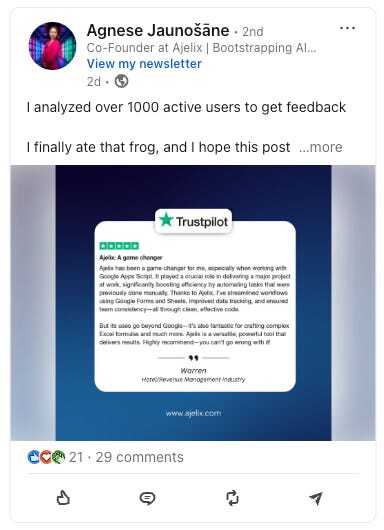 https://www.linkedin.com/posts/agnese-ajelix_i-analyzed-over-1000-active-users-to-get-activity-7312443575944851460-LzEb
https://www.linkedin.com/posts/agnese-ajelix_i-analyzed-over-1000-active-users-to-get-activity-7312443575944851460-LzEbHere is a quick list of the most popular review sites for B2B products if you are new to it.

That was it, my friends.
Thanks for reading, but you know what would really move the needle in business? if you commit to collecting at least 5 pieces of social proof this week. I challenge you to do it! All you have to do is ask - nobody will stop liking you if you ask for feedback. Challenge accepted?
You can get proven templates, examples, and prompts on how to get and use social proof on your websites, sales decks, and ads in my 100+ Step GTM Checklist.

March 28, 2025
The Secret Ingredient Behind Massively Successful SaaS Companies: Reverse Trials
Dear GTM Strategists,
I’ve been obsessed with reverse trials ever since I got full access to Clay and built my very first contact list for outbound. The value I unlocked in those first few days? Wild. That experience flipped a switch in my brain—reverse trials aren’t just a clever GTM tactic, they’re essential if you’re running an AI product and want to control costs while still driving activation.
To unpack this powerful concept even further, I’ve invited my brilliant friend Yaakov Carno to share his perspective with you. Yaakov and I have collaborated on several projects, and there’s something I have to tell you—every time I speak to his clients, they rave about him like he’s an internal team member. That level of trust is rare. He’s also worked with Databox (yes, the amazing product analytics company from Slovenia—my home country ), so he knows this game inside and out.
In this Substack, you'll find clear, practical insights to help you figure out if reverse trials are the right spiel for your GTM motion.
Yaakov, the floor is yours, mate.
There’s a reason why some SaaS companies hit that hockey-stick growth while others struggle to convert free users into paying customers. This is especially true in the world of product-led growth (PLG), where companies rely on self-serve models that let users try before they buy.
And here’s the kicker: it’s not just about having a killer product. It’s about how you let users experience that product.
Enter reverse trials. This is the secret weapon companies like Airtable, Notion, Canva, and Databox are using to drive massive free-to-paid conversions. I’ve implemented reverse trials firsthand with my clients, and the results speak for themselves—doubling free-to-paid conversions and significantly increasing activation rates.
Today, I’m going to break down why reverse trials are the future of SaaS growth. If you have a freemium model, you need to seriously consider how a reverse trial could help you convert more free users into paying customers.
Why Traditional Free Trials Are Failing YouMost SaaS companies stick to one of two models:
A traditional free trial: Users get premium features for a limited time before deciding whether to pay.
A traditional freemium model: Users get a limited version of the product for free, indefinitely.
Sounds logical, right? But here’s the problem:
Users don’t experience the “aha” moment fast enough. They’re often stuck in onboarding before they even get to the good stuff.
Feature gating kills engagement. If your best features are locked, free users never see the full value of your product.
Users don’t explore the product enough. By the time the trial ends, they haven’t formed a habit or built enough dependency to justify paying.
The result? Lower conversions, high churn, and wasted acquisition costs.
What Is a Reverse Trial?A reverse trial flips the script. Instead of starting users on a free plan or limiting their experience, they get premium access from day one.
Here’s how it works:
Users get full premium access for a limited period (e.g., 7 or 14 days).
When the trial ends, they don’t lose access completely—they downgrade to a free plan unless they choose to upgrade.
This means users get the best of both worlds: the full premium experience upfront and the option to continue using a free version even after the trial ends. With a traditional trial, once your time is up, you’re locked out.
Different types of reverse trials:
Full reverse trial: Automatic premium access for a set time, no user action required.
Opt-in reverse trial: Users start on a free plan and can opt into a trial of premium features.
Credit card required trials: Some companies require a credit card upfront to filter out low-intent users.
Usage-limited reverse trials: More common in AI and usage-based SaaS, where premium features are unlocked based on usage caps.

Compared to traditional trials and freemium models, reverse trials allow users to fully experience the product, creating a natural progression toward payment.
When to Use (and When NOT to Use) a Reverse TrialReverse trials are best when:
Activation depends on premium features (users need access to experience full value).
A free plan limits initial value delivery.
You want to drive natural feature discovery and engagement.
Potential pitfalls:
Overwhelming users with too many features.
High churn if users don’t see enough value to upgrade.
Risky for AI/usage-based SaaS where credit costs are high.
 Why Reverse Trials Work So Well
Why Reverse Trials Work So WellA few key psychological triggers make reverse trials incredibly effective:
The Endowment Effect: Once users have something, they’re more likely to want to keep it. Studies show that people value things more when they own them—even temporarily. This is why retailers offer free samples or why test-driving a car makes people more likely to buy it. In SaaS, when users have premium features, they feel a sense of ownership and are reluctant to give them up.
Fear of Missing Out (FOMO): Users who experience premium features and see their value are more likely to upgrade because they don’t want to lose what they’ve already gained. This is similar to how social media platforms keep users engaged by showing them what they’re missing out on. SaaS companies like Canva use well-placed reminders about premium benefits to nudge users toward upgrading.
Loss Aversion: People prefer avoiding losses to acquiring equivalent gains. When a user experiences the full product and then faces the prospect of losing access, they feel that loss much more acutely than they would feel the benefit of gaining those features later.
Brilliant example from Canva. Kyle Poyar shared his experience when he tried to downgrade from the premium plan:
"I went to cancel my Canva for Teams account today -- but Canva's cancellation flow was so good that I changed my mind. And, no, it wasn't because they made me jump through hoops.
They reminded me that I have an amazing deal. I still pay $12.95/month, but prices have increased to $29.99/month. I'll lose my deal if I cancel.
They created loss aversion by reminding me of the premium features I've put to use.
They made some clever UX choices that subtly influenced my decision."
 Source
SourceSimilarly, Calendly uses loss aversion in their end-of-trial emails, reminding users of premium features they used and highlighting what they’d lose by downgrading.
Full Product Experience: Instead of seeing just a fraction of what your product can do, users get the complete picture, making it easier to justify paying for it. Imagine trying to sell a car without letting someone test drive it—reverse trials remove that barrier.
Reverse Trial Case StudiesDatabox: Driving Activation Through Premium AccessBefore implementing a reverse trial, we saw a troubling pattern at Databox: Users were signing up, getting through initial onboarding, and then… nothing. They weren’t activating the core integrations that made the product truly valuable. And the biggest problem? They weren’t even opting into the free trial manually.
 Before: users had to manually opt into a free trial
Before: users had to manually opt into a free trialWe dug into the data and found that over 50% of users who could start a 14-day trial to unlock key integrations like Google Sheets simply weren’t doing it. They weren’t necessarily uninterested—they just weren’t reaching that point of realizing they needed it.
So we flipped the model. Instead of making users opt in, we gave every new user full access to all premium integrations from day one. The results were incredible:
Activation rates jumped as users explored integrations they otherwise would’ve missed.
More users upgraded to higher-tier plans after experiencing the advanced features.
Even downgraded users retained a stronger connection to the product because they had already built workflows with those premium features.
 Now: Databox gives every new user full access to all premium integrations for 14 daysStockpress: Increasing Perceived Value Through Feature Exposure
Now: Databox gives every new user full access to all premium integrations for 14 daysStockpress: Increasing Perceived Value Through Feature ExposureStockpress faced a different problem: users weren’t seeing the value of their premium features. The product was powerful, but free users weren’t experiencing its full potential because features were gated behind a paywall.
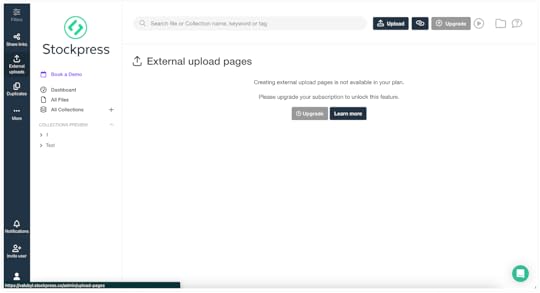 Before: users could not experience premium features before the purchase
Before: users could not experience premium features before the purchaseWe introduced a 14-day full reverse trial, putting all premium features in front of every user. And here’s what happened:
Free-to-paid conversion more than doubled (from 10% to 25%).

Users engaged with more premium features, which reinforced the overall product value.
We saw a higher uptake of premium plans because users experienced features they hadn’t previously considered essential.
 Now: Stockpress users can trial premium features, and the conversion has more than doubled
Now: Stockpress users can trial premium features, and the conversion has more than doubled
 Stockpress’s invitation to reverse trialReverse Trials for AI and Usage-Based SaaS
Stockpress’s invitation to reverse trialReverse Trials for AI and Usage-Based SaaSAI-powered and usage-based SaaS products face a unique challenge: Premium features often come with real costs. Unlike software products where access is free to the company, AI tools require compute power, and API-based SaaS often incurs usage fees. So how do you give users enough exposure to premium features without burning a hole in your company’s pocket?
One great example is PhotoRoom, which smartly limits access to AI-generated images while still offering a taste of the premium experience. Instead of unlimited access, they allow users to experience their AI-powered background remover but place a cap on free use. Once users see the magic, they’re far more likely to upgrade.
Some key approaches SaaS companies can take:
Usage-limited trials: Give users a set number of AI credits instead of unlimited access.
Opt-in premium trials with credit card requirements: This filters for high-intent users while still letting them experience premium features.
Highlighting delivered value: Canva does this exceptionally well, reminding users of everything they’ve created with premium features before they downgrade.
The key is balance: giving users enough of the premium experience to hook them, without overextending on costly resources.
Examples of Companies Using Reverse TrialsAirtable - All users start with a reverse trial.
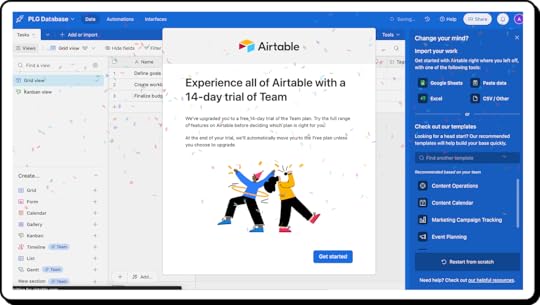
Clay - All users start with a reverse trial but have limited credit usage.

PhotoRoom - Users opt into a reverse trial with a credit card.

To dive deeper into more examples, you can check out this great piece by Elena Verna.
Best Practices for Implementing Reverse TrialsStep-by-Step Checklist
Decide on the reverse trial type (full, opt-in, credit card required, usage-based).
Choose the trial length (7-14 days is usually ideal).
Design an onboarding flow that highlights key premium features.
Clearly communicate the trial benefits via in-app messaging and emails.
Set up reminders (e.g., “Your premium access expires in 3 days!”).
Ensure a seamless downgrade experience so users don’t feel tricked.
Offer trial extensions to engaged users who need more time - OPTIONAL.
Track both activation and conversion rates and optimize based on data. (You want to understand the effects on both monetization and product adoption.)

Common Mistakes to Avoid
Failing to explain what happens after the trial ends.
Overwhelming users with too many premium features at once.
Creating a harsh downgrade experience that frustrates users.
Post-Trial Retention Strategies
Keep downgraded users engaged with feature teasers.
Send follow-up emails with limited-time upgrade offers.
Provide insights on what they achieved during the trial (e.g., “You edited 10 videos with our AI tool!”).
ConclusionI strongly believe that if your SaaS product has a freemium model, you must consider a reverse trial.
Reverse trials are one of the best levers for product-led growth. If you’re not experimenting with them, you’re leaving money on the table.
Have you tried implementing a reverse trial? Let’s discuss—I’d love to hear what’s worked (or hasn’t) for you!
💬 Trying to improve your free trial conversions in your PLG motion?
Yaakov is the go-to expert when it comes to designing trial experiences that actually convert. Whether you’re exploring a reverse trial, rethinking your activation strategy, or trying to guide users to value faster - he’s helped dozens of SaaS companies do exactly that.
If you're building in AI, PLG SaaS, or have a complex product that needs a powerful onboarding flow, Yaakov’s insights could save you months of trial-and-error.
His clients often call him “part of the team” - and I can vouch for that 100%.
👉 Is your trial experience underperforming?
👉 Struggling to get users to an aha moment before they churn?
👉 Want to drive adoption without overwhelming users - or your AI budget?
Drop Yaakov a message on LinkedIn or shoot him an email. He’s incredibly generous with his expertise and always up for a good GTM brainstorm.
My new product: GTM Checklist with AI Prompts ✨I launched the Go-to-Market Checklist with AI Prompts. It consists of 100+ tasks to get new customers for tech products in under 14 days.
It is an upgrade of my best-selling step-by-step checklist that will get you from launch planning to scaling profitably and faster - now with the help of AI.

March 21, 2025
AI Is the Biggest Shift in GTM Since Digital Marketing
Dear GTM Strategist!
AI is here to stay and transform how we go to market. Last week, we established that in the mainstream adoption, there is a lot of talk and little action (84% of companies saying that AI is a strategic priority, only 20-30% using it daily, Source: HBR).
This week, I want to invite you on a journey of how early adopters of AI in GTM are pioneering the change. My colleague Jonathan Kvarfordt, revenue enablement expert and AI GTM Advisor, created a GTM AI 2025 Report. 276 AI GTM early adopters pitched in. Since we supported the survey, we have gotten an early preview of his work, and in this post, I’d like to share with you five things I found most interesting:
GTM practitioners are most interested in use cases, ROI, and practical implementation of methodologies - most users use mainstream tools such as ChatGPT, Copilot, Claude, Jasper…
The best predictor of AI adoption is the enthusiasm for learning AI and playing with its implementations.
More AI tools do not equal better adoption - after the 4th tool, there are diminishing returns.
Beginners are worried about technical implementations. Experts care almost exclusively about strategic implementations.
Predictive trends and emerging technologies for GTM AI in 2025 and beyond.
What struck me the most about this report is that our curiosity about AI tools is an excellent predictor of the successful adoption of AI tools to elevate our GTM efforts - as long as we keep focus. Swinging from one hot AI tool to another will not yield great results.
Let’s learn what early adopters of AI in GTM are doing right and what best practices we could implement in our org! ✌️

This post is sponsored by Momentum.
Momentum is an enterprise listening platform for revenue teams that uses advanced AI agents to transform your customer conversations - emails, calls, support tickets- into actionable insights for revenue success.
Now, exclusively through Momentum Partners like Deepview, we're excited to launch our Prompt Library—a curated collection of 200+ high-impact prompts engineered by our lead prompt expert to supercharge Sales, Customer Success, Marketing, RevOps, and Leadership teams.
Opt in now to unlock these powerful tools and take your go-to-market strategy to the next level for free.
P.S.: I pitched in with a couple of prompts, too!
1) You can still become an early adopter of AI in GTMWhat was fascinating for me to see in this report is that no matter all the FOMO we get on social media, we are still early in the space if we have AI implementations that bring value. From the chart below, you see that the majority of GTM leaders use mainstream tools such as ChatGPT, Copilot, Claude, Jasper, etc.
Predominant use cases for AI implementation highlighted in the report were content creation (68%), customer intelligence (64%), process automation (62%), analytics enhancement (59%), and personalization (57%). Well, that is not too difficult, is it? At least for AI content creation, you can do a decent custom GPT in less than a day and train it on your assets to sound more like you.

My advice: Definitely use AI to enhance your content creation, but start learning GTM engineering too. Alex Lindahl, GTM Engineer at Clay, defined 2025 GTM Engineering trends (on the picture below), and my prediction is that signal-driven pipeline generation is going to massively transform the way how we do account-based marketing and sales as well as warm and cold outreach. The way how we orchestrate our data, bring different tools together and create leverage by our AI agents and copilots working together will bring the true AI-driven competitive edge. Automations are cool, but added value that generative AI unlocks is unseen. The rest of us create a competitive edge with added value and generative AI unlocks unseen opportunities here.
 Source2) The cards are shifting - your curiosity is the best predictor of successful AI implementation
Source2) The cards are shifting - your curiosity is the best predictor of successful AI implementationBrian Balfour highlighted that the rise of AI is one of the biggest disruptors of product-market fit of established organizations. Companies can lose product-market fit overnight due to lower entry barriers and increased capacities to add value of new entrants in the industry that use generative AI.
In the GTM AI 2025 Report this is beautifully highlighted on two charts. The first one illustrates that the budgets for AI are not the best predictor of successful AI adoption (these are monthly budgets per employee). The second one illustrates that our enthusiasm for learning AI and playing with its implementations is a much better predictor of adoption. I love that!


My advice: Spend at least 8-10 hours a week learning and implementing AI. To me, this is the single most important habit that I am developing in 2025. Seriously, do it if you want to have skin in the game. Occasional thought exchanges with GPT about the best tourist places to visit in Albania or arguing with it about the best goulash recipe do not make you a proficient AI user (hi, mom). Develop a strategic AI adoption agenda for your organization, or even better, start developing new products and offers with it because now, more than ever, small teams that utilize AI to its full potential set up new growth records.
 3) More tools do not mean better ROI - diminishing returns on 4th tool
3) More tools do not mean better ROI - diminishing returns on 4th toolMost proficient AI users in the report stated that they use 4-6 AI tools, but the overall data shows that productivity leaps dramatically up to 40% with 4 AI tools. Instead of constantly shopping for the latest and greatest AIs, we should squeeze the most added value out of our existing tools.

My advice: Choose your tools and stick to them (and leave 20% of capacities for experimentation). Every time someone asks me what AI tools I am using daily, I will answer differently. In my stack, there are always 3 main AI tools that I have been using for more than a year (ChatGPT, Claude, Clay) and up to 4 tools that I am currently experimenting with for parts of my businesses that I need to optimize. Currently, I am playing with AI SDR agents, tools for social selling, and AI tools for content creation. I test them for at least a quarter before making the final call on what stays and what goes. People also often ask me where do I find ideas for new tools? More likely than not, they find me, my colleagues recommend them, or I learned about them on LinkedIn or AI newsletters that I follow.
Oh, one more thing!
If you are an AI tool maker - lead with use cases! Most early adopters are interested in what they can do with AI. Check this out.
 4) Beginners worry about technical implementations, pros only care about strategic implementation
4) Beginners worry about technical implementations, pros only care about strategic implementationThe survey indicated an interesting paradox: the more advanced AI users are, the fewer technical concerns and the more strategic concerns they have. Though large organizations and Europe care deeply about data privacy and compliance - what else is new in the universe?
Strategic concerns are mainly connected with AI's role in organization strategy, adoption, integrability of data, structures of how trust and confidence are being built, and what additional capacities create business value and competitive edge. The survey provided interesting insights in the AI adoption barriers - a leading factor was lack of skills and education (32%), integration complexity (23%), and budget constraints (18%) followed by uncertain ROI.

My advice: Create an AI strategy for your organization as soon as possible. It is not about tools, it is how you use AI to create more competitive edge. Here is some food for thought that nicely wraps up our previous discussions.
 Source5) AI trends and predictions 🔮
Source5) AI trends and predictions 🔮GTM AI 2025 Report highlighted the following predictive trends and emerging technologies. What I found most interesting are predictive customer journeys in which you anticipate your user's future needs (that is very cool) and Human-AI collaborations - which is not saying: “Bad AI, let me show you how this is being done” - but seriously creating synergies between AI’s and our superpowers.
We have not yet seen the full power of personalization at scale. Data is abundant and cheap. You create a competitive edge by generating your own intelligence, not buying mass intelligence from a vendor - we will see more proprietary AIs in the future.
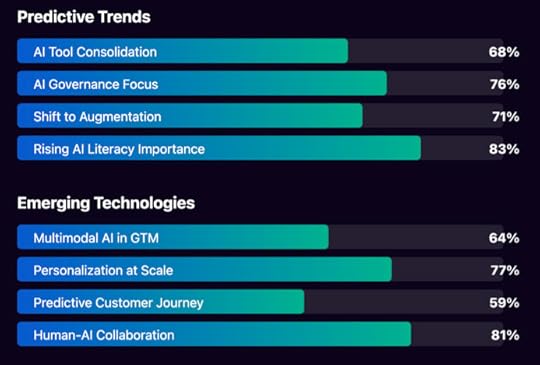
The GTM AI 2025 Report takes <1h to study, and you can download it here for free:
And if you want to dive deeper into AI, check out Jonathan’s GTM AI Academy with an All Pass AI for GTM space for $47/month.
Workshops included:
AI For Personalized Sales Communication
Enablement AI Powered
Generative AI Foundations
Mastering Claude.ai: Transformative Content Creation & Workflow Automation
Mastering Microsoft Co-pilot
AI for Creating Onboarding Programs
Prompt Guru Agent
AI Enablement Masters Certification
GTM Leaders AI Powered
Research & Automation with Perplexity.ai
Win the Market in the Age of AIAccording to LinkedIn, GTM strategy is one of the fastest-growing skills in 2025. Get ahead with my resources.
I just launched a new website where you can now browse all my products, including the best-selling GTM Strategist book, GTM Checklist with AI Prompts, and GTM Masterclass.
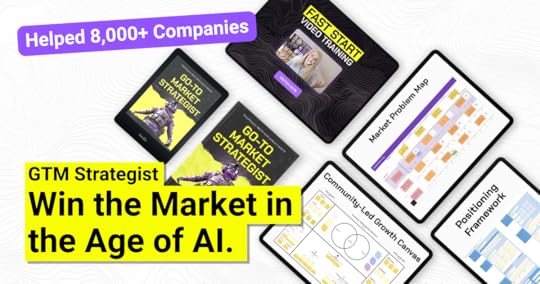
March 14, 2025
The Hidden Barriers to AI Adoption
You and I live in a bubble, my friend. We feel like it is almost “AI or die” at this point, but here is the reality:
83% of companies prioritize AI in their strategy, but only 20-30% use it daily (source). That’s a massive gap. Why?
The gap between ambition and execution is massive, and it’s not due to a lack of technology—it’s about people.
To make this paradox more relatable, here are some of the arguments I have heard while ear-dropping to customer interviews, usability tests, and sales demos of my teams (with fine intentions to make their landing pages, sales decks, and sales scripts better):
“Will this AI voice agent sound like a robot?”
“I don’t understand how it is doing what it is doing, and that scares the s*** out of me.”
“What if this AI SDRs spams my LinkedIn with generic messages and I get restricted from LinkedIn?”
“This AI could literally replace 5 people in the existing process. How can we make them use this solution, if they know that one day could replace them?” - and my favorite:
“Cool - I see this case study/pilot - but how can you guarantee this will work for me? Can we do the setup together?”
This is humans vs. AI IRL.
My job is to equip my teams to answer these objections that have little to nothing to do with technology per se.
We can solve these objections with some positioning and messaging tweaks, clever onboarding, marketing and sales tactics, and a lot of social proof.
In this post, we will dive into:
5 most common barriers to AI adoption defined by Ethical Intelligence Lab at Harvard Business School + how big corpos are dealing with them.
4 cases on how to bridge the AI adoption gap from small and medium businesses in my network that you can learn from.
If that sounds like a good use of your time and bandwidth,
Let’s rock and roll 🤘

This newsletter is sponsored by Brand24.
Interested in how to turn market chatter into a strategic advantage? Brand24 empowers you to tap into this potential with its social listening tools.
With real-time monitoring of over 25 million online sources—including social media, blogs, and podcasts—Brand24 keeps you one step ahead.
Whether you're tracking brand sentiment, evaluating campaign performance, or analyzing competitors, Brand24 offers actionable customer insights that fuel your strategic decisions.
Unlock an exclusive 10% discount on all Brand24 plans (valid for 90 days)!
 5 barriers to AI adoption by Harvard Business School and enterprise examples of how to address them
5 barriers to AI adoption by Harvard Business School and enterprise examples of how to address themKnow your enemy. What are we up against?
In his extensive research, Julian De Freitas, Director of the Ethical Intelligence Lab at Harvard Business School, identified five key factors contributing to AI resistance:
Perceived Threat to Autonomy: To many, AI is a black box and people do not understand why it is doing what it is doing. Imagine if you are a pilot flying a plane … The more severe the decisions are, the pressing this problem becomes
Lack of Trust in AI: You know when your AI assistant hallucinates? There are (sometimes valid) concerns about AI's reliability, transparency, and potential biases.
Fear of Job Displacement: 74% of Americans are concerned that AI will cause job losses within the next 12 months (Forbes).
Ethical and Privacy Concerns: Fear of what happens to your data when you feed it to AI: worries about personal privacy or unethical use are another barrier to AI adoption.
Complexity and Understanding: If you do not understand what it can do (for you), you are unlikely to use this technology. Fastest growing European startup Lovable grew to $17M ARR in 3 months because the product is just wow - most of the AI products are very clunky and difficult to use.
Sounds familiar?
As technology matures, users are not just awed by anything it produces. We learned how to think critically about AI capabilities and its role in the evolution of our society.
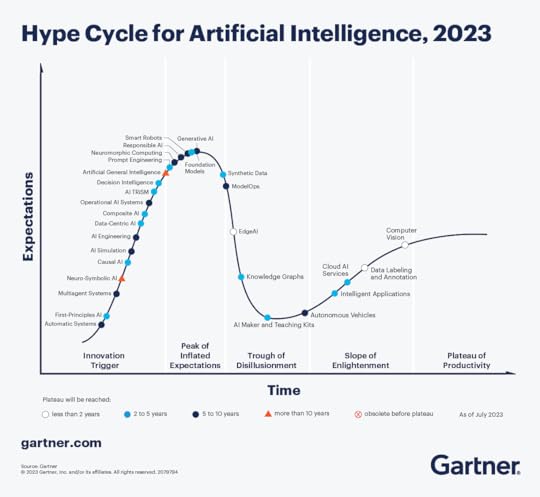 This is how Gartner envisioned the AI hype cycle in 2023
This is how Gartner envisioned the AI hype cycle in 2023Back in 2023, we were thinking, “Oh, cute, AI can draw a picture.”
 DALL-E missed my hair color and forgot to add a baguette - I will eat so much white bread there 🥖-nomnom
DALL-E missed my hair color and forgot to add a baguette - I will eat so much white bread there 🥖-nomnomBut if I have to put $5000 budget in promoting that image for my Paris workshop tour, I will prompt the s*** out of it before I would be satisfied with the outcome.
Enterprises have developed many clever strategies and tactics to address these concerns:
Most AI assistants like Siri, Alexa, etc. use female voices and even speech disruptors such as “hmmm, ammm…” to make them perceived to be more emotional and human.
Netflix calls its recommendation engine machine learning, not AI.
Google implemented transparent AI development practices, openly sharing algorithms and decision-making processes to build user trust.
IBM developed the "AI Fairness 360" toolkit to detect and mitigate biases in AI systems, addressing ethical concerns and promoting fairness.
Microsoft launched AI literacy programs to educate the public and demystify AI technologies, reducing fears associated with complexity.
Salesforce introduced AI tools designed to augment human work rather than replace it, alleviating fears of job displacement among employees.
Apple prioritized user privacy in AI applications, ensuring data protection and addressing concerns related to ethical and privacy issues.

Now, I know what you are thinking:
“Those companies have millions to do it - what can I do to bridge the AI adoption gap with my resources?”
No worries, I have you covered too.
Next, we will dive into more relatable examples for 90% of readers of the GTM Strategist.
4 cases of bridging an AI adoption gap from relatable companies in my networkHere is a curated list of companies I work with that might spark some new ideas into improving user experience, onboarding, and your positioning/messaging to bridge the gap from early adopters to slowly but surely reaching the early majority.
#1 Adapt the expectations and show how the output was generatedI was working with Linkbound this weekend, a tool to “turn likes into leads” on LinkedIn. You guessed it: a social selling tool. Their wow factor is that they filter leads for you based on your LinkedIn history and suggest the best social selling scripts based on detailed analysis of interactions.
Pay attention to the disclaimer in the video.
Based on our past interactions (analysis of 174 reactions and 162 comments), AI “knows” Jonathan. I only provided a short CTA. Is it perfect yet? Nope, but it is perfect enough. I can do a couple of tweaks to make it “sound more like me,” and this one is good to go. I trust this v01 because it was suggested based on our past interactions and generated from a specific post he engaged with.
#2 AI does not have to sound like a robot 🤖echowin is a platform for building AI agents (voice and chat). I will share two best practices from them - one internal and one external.
Meet Mars 🐶, one of my favorite coworkers. The team developed it using their platform as a Discord agent for internal communication. Mars makes v01 LinkedIn posts for the team, imports to-dos from our workshops to their ClickUp, saves resources we share to dedicated lists, and so much more. I love interacting with Mars. It makes our communication more effective and fun.
Now, to a more serious example: echowin offers a platform on which companies can build AI voice agents. One of their best use cases is Jiffy Lube, an American automotive oil change specialty shop chain. They have seen a 5X increase in customer appointments with echowin’s AI-powered phone agents.
But the number one concern when someone mentions “AI receptionist” is that it will sound like a dumb robot, especially in multi-ligual communication. To bridge this gap, the team has developed a “sandbox”, where you can have a real call with a voice agent you care developing. I was shocked when I tried to speak in Spanish with it and it spoke much better than I 😀.
Show, do not tell!
Try echowin’s sandbox here: https://echo.win/auth/signup
#3 Make friends with humans - instead of threatening themA Forbes survey found that 77% of workers worry AI will replace jobs within a year. It is natural to expect they will be reluctant to embrace the tools that put their livelihood in perceived jeopardy. But I am not on the “Matrix” team here.
 Provocative campaign by Artisan
Provocative campaign by ArtisanWhile “replace humans with AIs to do grunt work” pitch actually works on some higher-up decision makers as a part of cost and error reductions mantra, it will backfire at the end-user level unless it is communicated as an enhancer, not a replacement.
The problem is that “those BDRs” are decision-makers in your buying committee.
This is the pitch that I like a lot.
Swan AI agent helps you to identify website traffic and start social and email selling sequences (warm outreach) to close more deals. Instead of “fire SDRs”, the team knows that whenever you get a response, a human will more likely than not have to close the sale. In this section of the website (positioning/messaging), they pitch that this technology is helping sales teams to be more successful, not replacing humans with AI bots.
 Source: https://www.getswan.com
Source: https://www.getswan.comSwan’s CEO and co-founder Amos Bar Joseph generated $400k of qualified pipeline in 30 days all by himself using the Swan AI agent. His LinkedIn content brings a lot of traffic to their website, so Swan helps him focus on the conversations that matter and scale ultra targeted outreach.
#4 Lead with use cases and templates, and fight the “blank page” problem 📃
“The smartest GTM teams are not looking to replace their SDRs with AI, they are looking to turn their sellers into 100x superhumans with human+AI collaboration.”
Amos Bar Joseph, CEO and co-founder, Swan
The reality is that the AI knowledge gap between the makers of AI and AI users is HUGE for most companies. Yes, people know that they should be embracing and learning about AI, but in reality, most decision-makers in business do not even use mainstream AI tools such as ChatGPT, Claude, and Microsoft Copilot in the moment.
Three practices that I have seen working well with my teams are:
White glove onboarding - meaning that “demo” is more of making a setup for them together - works great when you are starting out. Gets unscalable/too expensive later on for product-led companies with annual revenue below
Upsell the education sessions and onboarding to learn how to do it together - I like this one because it is usually an extra revenue in most cases.
Provide them with templates, pre-setting options, and other “never stare at a blank page” solutions that you can think of. Do not make them think too hard. Drive the adoption by providing ideas on how users can benefit from your solution, educate them, and ultimately empower them to do a better job. In simple words, you tell me what to do with it so I can get what I want. 🤠
When we did a setup for Brand24, a good onboarding was precisely the case. Look, I know very little about clipping and online reputation and social listening tools; all I wanted was to see how my brands are performing on other social media. I am very active on LinkedIn, but X, YouTube, Reddit and other places remained a mystery to me. If I cannot handle more than one channel properly, how hard can that be for bigger brands that have 40,000 mentions a day, not 40 like me? 😅
What is genius here is that you can use Brand24 for competitor research instead of your brand if you are not big enough yet to care about this or are just up to getting some of their undeserved markets who are campaigning online, writing bad reviews, and desperately searching for alternatives.
Moreover, Brand24 also comes with an AI brand assistant and anomaly detector. See - I would not quickly figure that out as a noob user. That is good AI comm: what I can do with it (something that I actually care for), not merely what it does. I get bored if you are just namedropping features - on demos and in real life.
Very cool!
Hope you enjoyed our stroll down the AI adoption chasm. I will never forget what one of the founders I was working with said: "Technology is evolving much faster than social sciences. We have so little to operate there that it is best if we just share experience with each other." So, I would like to ask you to co-create this content with me.
Have you encountered resistance to AI in your organization?
What strategies have worked (or failed)?
I’d love to hear your thoughts in the comments.
Want more guidance on finding customers for your AI product?I’m starting a live course on how to Launch and Scale AI Products Profitably at the end of this month. It will be a unique opportunity to work directly with me in a small group. Check out the whole curriculum and more on the link below, and use the code GOTOMARKET for a 100$ discount.

If you have any questions regarding the enrollment, I am one email away.
March 7, 2025
Pricing: From WTF to WTP (Willingness to Pay)
Before we begin, I have a really cool announcement - I will host my first live cohort on Maven! It is a unique opportunity to get hands-on knowledge on how to launch and scale AI products profitably. Learn more at the end of this post.
Most GTM missions fail not because of poor products but due to business model, monetization, and pricing issues. Philip Kotler famously said: “All the other elements of Marketing Mix spend money - Pricing makes it.” This is how I fell in love with pricing.
Last week, I ran an AI Products Pricing workshop for one of my favorite partners, a VC. Here are 3 pricing lessons I would like to share with you so you can do better than those 72% of companies that face pricing, monetization and business model issues:
Pricing = value transfer.
Most new players end up pricing in a 20-30% wiggle room of competition.
If you make it slightly cheaper, people will not magically want it more.
The article is structured in a way that I first present a lesson, followed by a framework and a tool for how you can DIY this and apply it to your business.
Content-wise, we will dive into value metrics and how to use them in pricing: pricing competition moodboards, we will also mention experimentation, packaging and pricing psychology.
I can assure you that this one will be easy to grasp even if you are entirely new to pricing, but it still has some value gems “from the field” that will make it worth reading even if you are a pricing pro.
If you like making money, you will like pricing.
Let’s rock and roll!

This newsletter is sponsored by Attio.
Most CRMs were built for yesterday's businesses. Attio is built for what's next.
Attio is an AI-native CRM built specifically for the next era of companies. It’s flexible, easily configures to your unique data structures, and adapts to any business model - taking you scale from seed stage to category leader.
With Attio, your powerful CRM builds itself in minutes through automatic data sync and enrichment. Then unleash the full power of the platform - from AI-powered automations that handle even your most complex business processes, to our research agent that can help with prospecting and lead routing at scale.
Join industry leaders like Flatfile, Replicate, Modal and more.
Try the CRM that’s built for the future. Start a free Attio trial today.
#1 Pricing is all about the value transfer ✨This is how I explain pricing to my teams:
“Your product delivers the value added to target customers; with pricing, we capture added value back to build a sustainable business.”
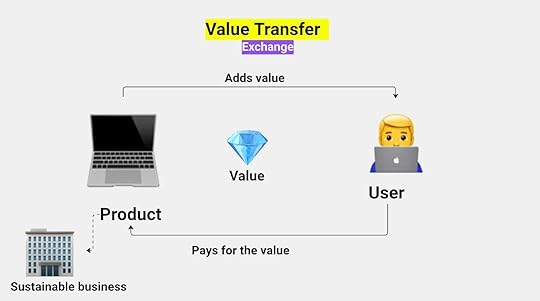
And that is great if you are a payment processor like Stripe, Gumroad, or Paypal. You can just take 3-5% of whatever money is being made and no one can argue 🤠.
But for the rest of us, how much value is being created?
Anecdotally, we could be capturing 10-30% of added value created by our product in SaaS, but let’s be slightly more specific.
Most of us use a Value Metric to measure the value exchange of our product.
In practice, we do not really have a perfect feedback loop to measure a value metric. We have to use proxies.
My mission with the GTM Strategist is to help you build and grow profitable businesses. Do I know for all 10,000 companies affected a year how much more money was there made?
I do for some, but not most, so I have to rely on value metric proxies to measure the value added. My proxies are number of customers, testimonials, growth rates, recommendations, and signals of referrals (mentions, shares, attribution analysis for WOM).
And I am not alone here. Many companies have to use proxies to translate the value being created to the product to their pricing pages.
 Selected examples of value metrics, its proxies and how they are reflected in pricing
Selected examples of value metrics, its proxies and how they are reflected in pricingWhat could your value metrics be?
#2 Most new players end up pricing in a 20-30% wiggle room of competitionThere is some competition whenever there is an actual burning pain on the market. It can be a product, service, some sort of internal process, or “manual labor”. Your job is to figure out what customers compare you with - because they always do.
Imagine your competitor alternatives on a pricing spectrum. How much value can you really deliver with the product as it is, and how much are charging competitive alternatives relevant to your target customer.
 An example of the competition pricing spectrum, assumptions + value proxy sanity check
An example of the competition pricing spectrum, assumptions + value proxy sanity checkAs a new player in the market, you are likely to be anchored to the competition price points whether you want it or not. If an ICP is right now paying $399 for a mass solution to send out LinkedIn DMs and has 10,000 customers, a superior customer success team and strong reputation on the market, it will be extremely hard to expect the same ICP that they should switch to a $499-per-month product because you claim it is better. Not entirely impossible, but very hard.
To comprehend this reality, I love to make pricing moodboards. Here is an example of one:
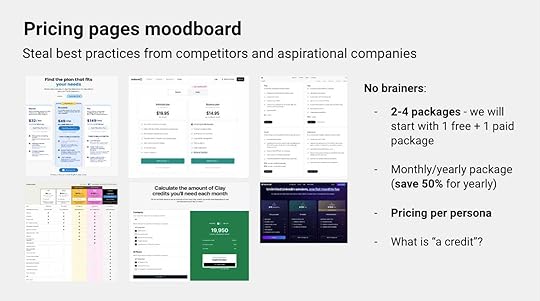 Example of a pricing moodboard for a content creation AI product for LinkedIn
Example of a pricing moodboard for a content creation AI product for LinkedInBut I get much more obsessed than that. I have pricing pages changes alerts, I go back and explore what previous pricing, I always check the pages of competitors in incognito and with VPNs so I see if they run some pricing experiments. I also like to keep historic screenshots of best-in-class companies when it comes to pricing to see how the industry is evolving. In simple words, whenever I see a cool pricing page, I’ll take a screenshot 📸.
#3 If you make it slightly cheaper, people will not magically want it moreI was studying economics. Now that I work in tech, I believe that the supply-and-demand curve is a scam 🤠.
In microeconomics, pricing equilibrium is established at a point where the motivation of customers to buy at cheaper prices and the motivation of suppliers to produce goods and make more money somehow balances. And that is cool if you mine coal or produce sugar beet, but we cannot copy-and-paste this mindset to tech products.
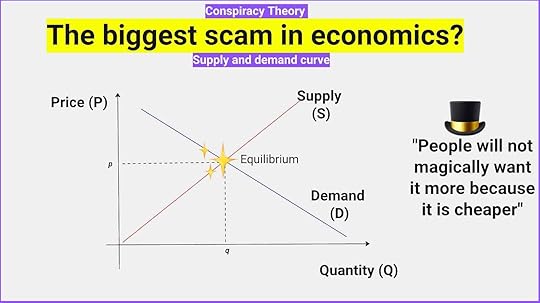
Resists the temptation to compete solely based on low price. In the end, there can utterly be only one cheapest player, and that is the race to the bottom, especially if you do not have massive capital reserves to optimize for adoption to create economies of scale and operational effectiveness due to the size of an organization to negotiate better terms than everything else or create a brutally effective Ikea-McDonalds standard operation procedures.
Most of us will have to compete on added value and HOW do you charge - Packaging can be a HUGE differentiator here. I will quickly grasp some AI examples here - if you offer a price per outcome/result and a service satisfaction guarantee, expected entry barriers are lower.
 This overview was inspired by Kyle Poyar
This overview was inspired by Kyle PoyarIn reality, many ways of capturing value in a way that is perceived fair by a customer and builds sustainable business for a supplier coexist and they continue to evolve.
Pricing is 50% Excel and 50% psychologyI love science. It makes me feel calm and in control of what is going on.
But pricing is more than a rational process.
Our lizard brain co-pilots our buying decisions.
Quick demo:
Seller: “This is my AI SDR agent, we only charge you $300 when you get a quality lead - zero risk, what a no-braner offer!”
Buyer: “How do you know what is a qualified lead - how about if it does not convert?”
(thinking - can I really trust you that you will not bring me 100 shit leads and cost me money)
Seller: “No problem. You will mark what a qualified lead is.”
Buyer: “But will it convert?”
Really thinking 🤔 / I still have to trust you that you bring me high-quality leads, my reputation is at stake and I like predictability of my pipeline and cost structure, too. My gain must be sizable enough that I feel it is worth investing in my process changes and cognitive load of learning the new tool. Oh no, but the deal is running out so I might grab it now and if it really sucks do refund if I do not like it later - FOMO is real 🤯
That, my dears, is pricing IRL.
The Power of ExperimentationBut once you embrace the irrationality of pricing, you can totally use it to your advantage.
The simplest pricing experiment I like to run is the price anchoring and decoy - aka popcorn pricing 🍿 on pricing pages. Let me give you two quick examples to bring this one home:
My media packages - In Q4 most customers wanted to start with the cheapest packages and I spent a lot of effort convincing them to opt for higher packages because they really bring so much more value. This is why in Q1 I marked the best-seller on my pages - the package for which I trust and recommend brings the most value. Guess what happened? No one buys the cheapest package anymore.
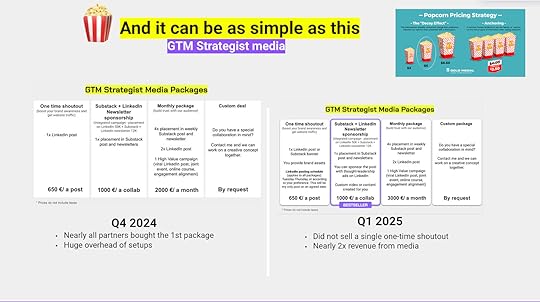 Most customers initially asked for a one-time shoutout but later wanted to expand the collaboration, so I revamped the packages to help them see more value
Most customers initially asked for a one-time shoutout but later wanted to expand the collaboration, so I revamped the packages to help them see more valueI find my best pricing examples in e-commerce where you literally have to fight for every cent to maintain healthy unit economics and LTVs - this is a brilliant example of a decoy - the third package being introduced only to make the original deal more effective. These are some supplements for joints that my mum takes, but I believe we can learn so much from this pricing page.
 The 3rd package is a total decoy - who on earth would want that? #1 looks like a no-brainer now
The 3rd package is a total decoy - who on earth would want that? #1 looks like a no-brainer nowOne other thing is true: as your products keep on getting better and better, you should be capturing more added value to the product - and you should be charging more. There will be new competitors, the technology will change and you might want to switch between “optimize for adoption” and “optimize for profit” modes.
Pricing it definitely not a set it and forget it exercise, it is an ongoing process while most companies should reconsider pricing at least once a quarter, best in class companies run pricing experiments all the time - you and I are probably not looking at the same version of Amazon if we open the page now.
For example, La Growth Machine runs two versions of the pricing page at the same time:


You know what else is true?
Inflation. That’s why you should review your pricing regularly, experiment, and adjust based on the learnings.

So I encourage you to fall in love with pricing. It will make a massive difference in your profitability.
Remember, the only element of marketing mix that makes money - others spend it.
There is so much more to unpack when it comes to pricing - I could easily write another 10 pages in the next hour, sharing many more examples, but you know what would be a 10X better option … I have a really cool pricing workshop that will help you build your pricing v01 by determining best practices in your arena, deciding on a value metric, testing willingness to pay on your target market and list your pricing experiments.
Want to get from pricing WTF to WTP (Willigness to Pay) with me?I’m starting my first cohort at the end of this month. It will be a unique opportunity to work directly with me in a small group. We will tackle much more than pricing: you will learn how to Launch and Scale AI Products Profitably.
To get a taste of it, I will host a free lightning lesson next week. Join me for a power hour where we will look at my most popular template together - register here.
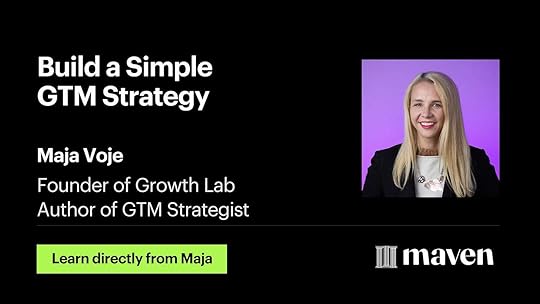
Until next week,
Maja
February 28, 2025
Userpilot’s Journey to $900,000 Pipeline & $200k Closed-Won in 135 Days with “Lean ABM”
Inbound took a massive hit in 2024/2025 - algo changes, more AI, cluttered landscape, diminishing returns … June 2024 was a bloodbath - companies lost up to 80% of organic traffic. ABM (Account-Based Marketing) came to the rescue for many of them. But how do you really kick off ABM motion?
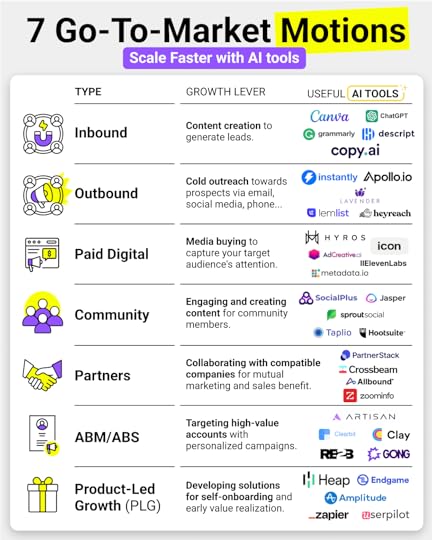 Here is how I define GTM Motions in case you are new here
Here is how I define GTM Motions in case you are new hereThere is so much fluff out there when it comes to ABM:
B2B infographics camouflaged as ABM
ABM done as warm outreach, aka social selling
“We made a $400m pipeline with 7 emails - I am giving it away for free -comment.”
So I avoided this topic for our Substack until I find someone I can really trust who will share the numbers, screenshots and learnings.
Luckily, Emilia Korczynska, VP of Marketing at Userpilot, has been ABM-ing in public on LinkedIn since Q4, so as soon as she had the conversion results in, I asked her if she could share their ABM experience with us.
Dive into LinkedIn ads, messaging, ABM plans, tools, the ROI of campaigns and many other different angles of this campaign that will help you decide if ABM is Yay or Nay for you.

This post is sponsored by Momentum.
Do you want free AI prompts to help you with ABM, sales, and all other go-to-market motions? Momentum just launched a MEGA prompt library with 200+ AI prompts by senior GTM experts Nick Bennett, Jonathan Kvarfordt, Daniel Disney, Christian Krause - and also some of my prompts. Grab it now - check my LinkedIn post for more details!

Let’s hear it from Emilia now:
We launched our first-ever ABM (Account Based Marketing) campaign on 15 September 2024. Beforehand, Userpilot, a multi-channel product growth platform, depended on inbound leads (mostly from our SEO blog content!) to fuel its growth. We were publishing 100+ blog posts per month and getting over 230,000 monthly visitors from organic search. But as our platform became more and more sophisticated (in late 2023, we launched product analytics, complementing our in-app onboarding and user feedback features) and we wanted to target larger, more mature companies - we quickly realised the inbound traffic would not be enough to build a predictable growth strategy. That plus - with AI and all the Google updates over the last few years - organic inbound growth became a lot more difficult, volatile and expensive.
So after some research - we decided to focus on ABM as our next growth channel. 3 months after launching our first-ever campaign - we had $650k in open pipeline. In 4.5 months - we had nearly $900,000 in open pipeline ($872,966) and $189,816 in Closed Won deals. And we didn’t spend a cent on “ABM tools”.
What is ABM & how to get started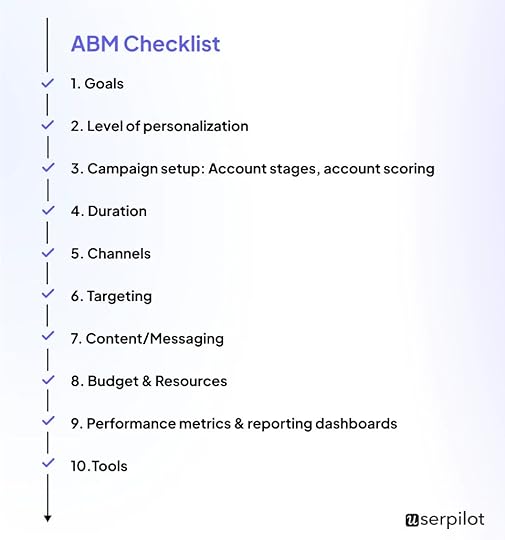
ABM is particularly effective when going upmarket - because instead of casting a wide net and seeing who comes in, you proactively identify a specific set of high-potential accounts and create hyper-personalized campaigns to engage them. Then - looking at which accounts & what the accounts are engaging in (intent signals) - you need scoop out the ones showing intent - and then funnel them into more and more personalized campaigns - also adding BDR outreach to these “warmed-up” accounts at some point.
Sounds simple - but the execution was far from simple. In fact - it took us over two months of prep (revops, systems for managing and running the campaigns, hiring an experienced ABM manager, creating campaign assets) to launch our first campaign.
It didn’t help that most ABM books and resources I’ve read are very high level - after all, nobody (except me 😅) wants to disclose exactly how much they’ve spent and made, what worked for them - or worse, what didn’t. And there’s a lot to consider when starting your first ABM campaign - as ABM (or ABX) has many “flavours”:
Goals: What are you trying to achieve with your ABM campaigns, what are your KPIs, which metrics are you going to track?
Level of personalization: Are you going to run one-to-many, one-to-few or one-to-one ABM campaigns?
Campaign setup: Account stages, account scoring: What stages will your ABM campaigns consist of? How will you score your accounts to push them into the stages?
Duration: How long will each of your campaigns last?
Channels: Which channels are you going to use to target your audience?
Account lists / targeting: Which company lists are you going to target, and how are you going to build them? How many personas are you going to target?
Content/Messaging: What content are you going to use to connect with your target accounts? How will you gauge the intent/interest of your target accounts to personalize your campaign messaging and make it more effective? At which point is your BDR team going to reach out to the target accounts?
Budget & Resources: How much can you spend on your campaigns? What is your monthly budget?
Performance metrics & reporting dashboards: How will you track your campaign performance?
Tools: What tool are you going to use for all of the above???
The “Lean ABM” ToolstackAs any ABM noob, I started working on our campaigns backwards - from looking for ABM tools.
And I was instantly daunted by the price tags - the lowest quote we got from an ABM platform was $32,000 with a two-year commitment, plus at least $100k recommended ad spend on their display ad networks.
The more research I did (and the more less-than-glowing user reviews I’ve read on Reddit) - the more convinced I was that those expensive ABM tools that score your accounts based on anonymized click signals from Private Ad Networks using Reverse IP lookup are too much of a risk for us to take.
Why? Website visitor deanonymization is very unreliable. According to this study by Syft - the most accurate of these tools, Clearbit - identifies visitors correctly only 42% of the time 😬

So pretty quickly, we decided to run our “lean” ABM program only on LinkedIn for starters, using just our CRM - Hubspot - to set up, manage, and track the results of our campaigns.
We still needed three other solutions:
A data enrichment tool to build out our account lists - we started from Apollo + BuiltWith, then moved to Clay
A tool to push our ad engagement data from LinkedIn into Hubspot - we started from Dreamdata & Fibbler, then moved to ZenABM
A tool for project management, to keep track of all the ad assets and assign tasks to asset creators, graphic designers and video makers - from the beginning, we’ve used Notion for this.
So, to sum up, we are currently using:
For list building: CRM (Hubspot) + Clay
For campaign asset management: Notion
For intent recognition and account scoring: ZenABM
For ad campaign management, lead flows, reporting and sales outreach - Hubspot marketing
BDRs’ tool for prospecting: SalesLoft
This toolstack is costing us ~$2500 per month
How to set up your first ABM campaign - ABM Goals, Campaign setup, level of personalization & durationOne thing we knew from the beginning was that we wanted to start from running a “one to many” ABM - targeting many accounts (with a shared characteristic) with ads. This play can be used to identify accounts with intent from the SAM - and then include them in more personalized campaigns and outreach.
We decided to align the ABM campaign stages with different stages of the “awareness funnel” - based on Kyle Poyar’s article “Your guide to GTM metrics 2.0” featuring “ABX benchmarks”.
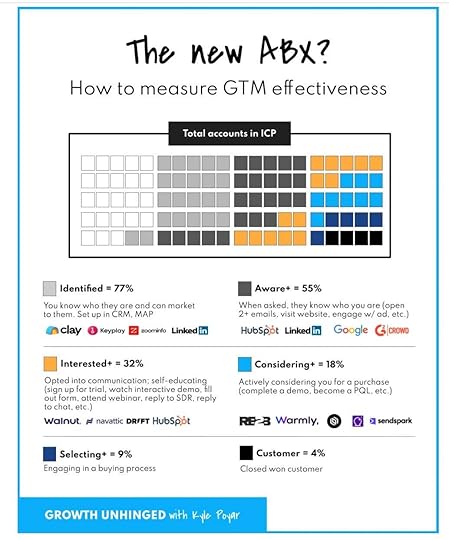
We structured our ABM campaign stages & account scoring as follows:
Identified - all the accounts we’re targeting in the campaign.
Aware - accounts with 50+ ad impressions.
Interested/Engaged - accounts with 5+ ad clicks or 10+ engagements.
Considering - accounts that booked a demo / signed up for a trial.
Selecting - accounts with an open deal.

The accounts in each state are then shown different content (ads) - the further down the funnel, the more product-oriented the content:
Identified and Awareness stage: Awareness content ads
Interested stage: Interested content ads
Consideration and Selecting stage: Consideration content ads
If this sounds simple - it is. But it wasn’t easy to set up for a number of reasons…
How do we apply the scores to accounts?First - we’re pushing the company-level engagement data (impressions, engagements, clicks) from LinkedIn Campaign Manager to Hubspot.
As of February 2025 - you can’t do this natively.
We didn’t find a tool that pushed both quantitative and qualitative engagements (which specific campaigns the account engaged with - we use that information for personalising BDR outreach). So we decided to build our own API solution with the help of my partner - ZenABM.
That way, we can push both total engagements and which campaigns the account engaged in into company properties on Hubspot:


Since the campaigns are already segmented by intent, 12 in our case, we can then create a workflow to assign the respective intent(s) in a custom multiple checkboxes company property on the company level based on the campaign names/intent coming in from ZenABM.
Based on the cumulative number of LinkedIn ad impressions and clicks, we move the companies that reached a certain account score between different active lists corresponding to the ABM stages.
Then, based on the list membership - we update the “ABM stage” company property with a workflow:

As soon as a company hits the “interested” stage - they get assigned to a BDR company owner.
Then when the BDRs prospect and create leads, the intent(s) associated with that company get copied to the lead level as tags. This helps the BDRs reach out with very relevant, targeted messages - based on what the company members have already engaged with.
Campaign Structure & Project ManagementTo really leverage the intent from our LinkedIn campaigns, we had to come up with a campaign structure that would work around LinkedIn’s limitations:
LinkedIn only allows you to serve campaigns when your audience size is at least 300 members.
You can only have one asset type (video, image, text, document etc.) per campaign.
For privacy reasons, LinkedIn API obfuscates engagements from less than 3 company members / less than 3 engagements in any given period of time.
After a lot of trial-and-error, we came up with the following Campaign structure:
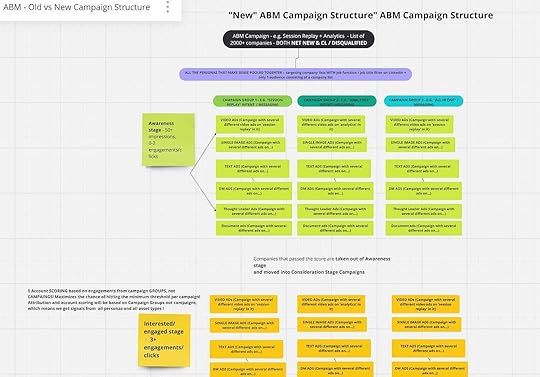
In each ABM campaign, we have 3 stages with different campaign groups based on shared intent (rather than different personas).
This structure allows us to gauge which “intent” each of the accounts targeted by this ABM campaign has.
Awareness stage - targeting accounts in the “Identified” and “Aware” ABM stages: e.g. 3-5 Campaign groups (different intents, e.g. different competitors, core value props etc.), with 5-7 Campaigns (different ad types - image, video etc.)
Engagement stage - targeting accounts in the “Interested/Engaged” stage - with structure as above;
Consideration stage - all accounts that moved to “considering” and “selecting” ABM stages.
IMPORTANT: you need to make sure you include your “intent” in your campaign group names to pass the right “intent” into the company property on Hubspot when your account interacts with it.
Project ManagementHow did we manage the process of creating all assets for all these different campaign groups without getting lost in it, and keeping our campaign names (which inform us about the intent!) in order?
Well, this is also something we had to grapple with at the beginning. Since our marketing team is a power user of Notion to manage all marketing initiatives - we tapped into Notion databases for ABM asset creation management too.
Using Notion databases, we assign the ad assets we need to create for each Campaign Group to specific “asset owners”, create asset brief templates, and assign the graphics creation task to our graphic designers automatically once the “asset owner” (another team member) ticked off the “asset brief done?” field.

We also use it to track which assets have been launched and which haven’t yet:
 Content & Messaging (+ Identifying Intent)
Content & Messaging (+ Identifying Intent)Now that I’ve walked you through our ABM campaign setup and tools - let’s look at the actual assets (and how they performed!)
As you know - we’ve settled on LinkedIn as our (for now only) channel - and we’re using different types of ads there, with the following mix from most used to least used:
Single image ads
Video ads
Thought Leader Ads
DM ads
Text ads
Document ads
In terms of inventory performance - the single image ads had the highest CTR and the lowest cost per click to landing page - followed by video ads and thought leader ads. The DM ads so far have been extremely expensive in terms of cost per conversion.

We use text ads to generate brand awareness - as they result in a high number of impressions at a negligible cost, but rarely translate into clicks.
Thought Leader Ads (TLAs) seemed great when it comes to the CTRs - but this metric is a bit misleading for LinkedIn Thought Leader Ads, as they count every click on the ad - including “read more”, author’s profiles, people tagged etc.

But they are very successful in driving attention to more “top of the funnel” assets like events and webinars - especially if the posts are coming from influencers popular with the ICP (and they are speakers at the promoted webinars/events). So in the upcoming campaigns, we are planning to use them in moderation in the “awareness” stage.
How many of the different types of ads are we using per campaign? This is what our inventory split per campaign looks like:
(Abbreviations: B=Benefit, F=Feature, J=JTBD, W=Webinar, A=Audit, E=Education, CS=Case Study, T=Testimonial, D=Demo)
 What Ads performed best for us?
What Ads performed best for us?Here are our top-performing ads from our first ABM campaign:
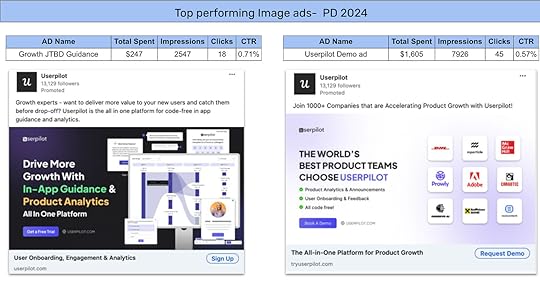



And most recently, from our new campaign launched in January:
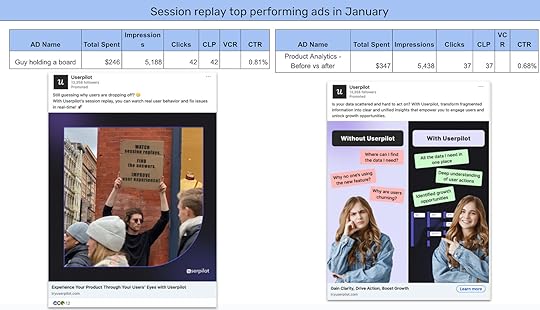

 Our ABM Goals & Budget
Our ABM Goals & BudgetFor 2025, we set an ambitious goal for our ABM campaigns: generate $3.5 million in pipeline with $350k in ad spend. That immediately gave us a leading metric (KPI) to monitor our campaign performance: pipeline per dollar spent. And ours is $10.
So far, we spent $ 98,673 and generated $872,966 in pipeline - which means $8.8 per $ spent - a little under our expectations. We’re constantly experimenting with all the levers we can push to improve it:
Creatives
Bidding strategy (e.g. moving from cost-per-click to target CPM for TLAs has improved our budget efficiency a lot!)
Account targeting
Account Targeting & List BuildingWhich brings me to my next point…
For our first campaign, we built the account list based on the “win-loss” analysis we did on our growth and enterprise deals, and used various targeting filters like company size, location etc.

Depending on the focus of each ABM campaign, we use different additional selection criteria for the companies we want to target. For example, for a campaign focusing on our new “Session Replay + Analytics” features, we would target lookalike companies to our enterprise customers, that also match the following:
Firmographic Fit:
Company Size: Must be either SMB (50–500 employees) or Mid-Market (500–2,000 employees).
Revenue: Preferably $5M+ in annual revenue or comparable funding (if this data is too hard to confirm, we skip it).
Industry: Must be digital-first (SaaS, eCommerce, EdTech, FinTech, HealthTech) with a product-led growth model.
Location: Focus on USA, Canada, Australia, New Zealand, Ireland, Israel, and Western/Northern Europe (e.g., Germany, Austria, Switzerland, France, Netherlands, Nordics).
Technographic Indicators (from BuiltWith or similar tools):
Currently Using or Previously Used an {use case} Competitor
Currently Using or Previously Used a Direct Competitor Lacking {feature}
Using Both {feature1} + {feature2} Tools: Any redundant combination of the above.
For this we used Clay and Builtwith’s API to build the list:

We also tap into our CRM data to uncover the right-sized accounts that we previously lost to competitors because of missing features:

Once we have a list of accounts we want to target, we add them to the right ABM campaign list on Hubspot and use a workflow to update the “ABM Campaign Name” Company property and the ABM stage (set to identified):

Accounts in these HubSpot active lists are sent to LinkedIn Campaign Manager using HubSpot Ad Audiences for dynamic ad targeting.
It usually takes around 48 hours for your audience to get ready on LinkedIn after being synced. Once available, you can use these lists with LinkedIn targeting options and add additional filters such as job function or role to further narrow down your audience for more precise targeting.
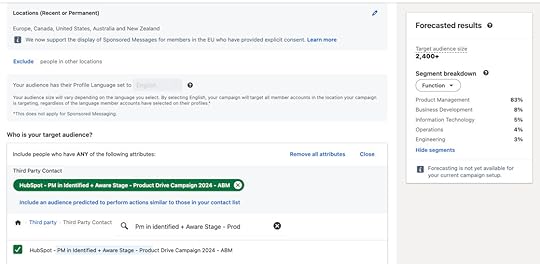
Now that the audience is ready, we can start running our ads.
All our accounts start in the "identified" stage. However, as soon as an account meets the ABM stage benchmarks (e.g., when an account receives more than 5 clicks, it moves to the "interested" stage - and the “awareness” ads are paused for them, and they are automatically enrolled in the “interested” stage ads).

The active lists are automatically updated based on account properties, and since these lists are used on LinkedIn, they are updated there as well.
This ensures that accounts are removed from the "identified" list and added to the "interested" list, and targeted with ads that are more aligned to their current stage.
This segmentation allowed us to craft highly targeted messaging tailored to each persona's pain points and their position in the ABM funnel.
Our Results (after 135 days - excluding “Christmas break”)To sum up, after our first ABM campaign ended, we can report on the following results:
Accounts Touched: 5548
Total Cost: $ 98,673 + $8000= ~ $107,000 (LinkedIn Ad spend + tools)
Pipeline Generated: $872,966
Pipeline per Dollar: $8.8
Assets: ~150 ads for 8 personas (images, videos, TLAs, DMs, text, docs)
Team: 4.5 people full-time (1 ABM manager, 0.5 performance manager, 1 MOps manager, 1 head of marketing, 0.5 demand gen + 0.5 PMM, 1 graphic designer.)
Final ThoughtsCold outbound alone took us 2x as long and cost 51% more to generate the same pipeline.
Starting ABM wasn’t easy by any means (the ops were still brutal), but it wasn’t any harder to set up than cold outbound—just faster at driving pipeline and less resource-intensive. We actually split asset creation across almost the entire marketing team, except for the content team.
At the end of the day, we were still harvesting demand rather than generating it. And it’s just much easier and faster to do that by putting a mix of different messaging in front of people, seeing what resonates to gauge intent (more on that later), and then confirming it on a call.
Hope this was helpful - if you have any questions reach out to me on LinkedIn!
My new product: GTM Checklist with AI Prompts ✨One week, I launched the Go-to-Market Checklist with AI Prompts. It consists of 100+ tasks to get new customers for tech products in under 14 days.
It is an upgrade of my best-selling step-by-step checklist that will get you from launch planning to scaling profitably and faster - now with the help of AI.

February 21, 2025
I Have a Go-To-Market Strategy. Now - Who Will Do the Work?
I see many teams building fantastic go-to-market strategies. Their plans are bulletproof. Founders feel confident about their world-domination plans. Rightfully so, because they have:
✔️ Learned the latest and most excellent GTM tactics and trends: AI, all-bound, ICP-first GTM
✔️ Received great advice from advisors, consultants, VCs, and professional communities.
✔️ Adopted state-of-the-art tools and hired top talent and consultants.
What could possibly go wrong?
(I hate to break it)
Poor execution.
Most people, not all, possess the intellectual capacity to come up with very well-defined go-to-market strategic work. Selecting the best tactics - what to do to get there - involves a bit of trial and error on top of collecting the right intelligence. But execution - well, that is where shit hits the fan.
By no means am I fetishizing “hard work” for the sake of hard work. You can work really hard towards the wrong objectives, and the net result is still the same - you don’t win.
One needs to “put in the reps” to execute what was agreed.
For a long time, we have been discussing how to develop a go-to-market strategy.
Now, it’s time to get physical.
In this article, I aim to mentally and tactically equip you to elevate your GTM execution muscle and put in the reps to move the needle in business. You will learn:
How I plan GTM execution for my teams
The rule of 100: Gamification of dull work
My mindful guide to outsourcing
If this sounds good, let’s give it a go!

This newsletter is sponsored by Attio.
Most CRMs were built for yesterday's businesses. Attio is built for what's next.
Attio is an AI-native CRM built specifically for the next era of companies. It’s flexible, easily configures to your unique data structures, and adapts to any business model - taking you scale from seed stage to category leader.
With Attio, your powerful CRM builds itself in minutes through automatic data sync and enrichment. Then unleash the full power of the platform - from AI-powered automations that handle even your most complex business processes, to our research agent that can help with prospecting and lead routing at scale.
Join industry leaders like Flatfile, Replicate, Modal and more.
Try the CRM that’s built for the future. Start a free Attio trial today.
GTM execution planning: How I make decisions with my teamsWorkshops are fun to do. We make plans, everyone feels good about the mission, and there is a certain pride in building a GTM strategy from scratch. It’s very exciting.
 If you have not taken my GTM Power Hour for a spin - do it. It is so good and actionable. Get the free template.
If you have not taken my GTM Power Hour for a spin - do it. It is so good and actionable. Get the free template.Workshops should conclude with commitments on what needs to be done and, ideally, who and when will do it (roadmap). Before committing to the roadmap, one needs to understand the resources at their disposal. By resources, I mean time, team, money, tools, and sometimes internal politics and willpower.
When it comes to GTM execution, you often send me a lot of questions that we’ll tackle today:
→ Can we outsource GTM to a partner? - I would not, but you can.
→ I do not have a team - can I do GTM solo? - Of course, you can. Even part-time.
→ Must I, as a founder, be involved in GTM? - No. But it is good if you are in the early stages.
You will grasp the logic really fast. There is no single right way how to do GTM. We work with what we have, we are trying to make the best out of it and it comes in many shapes and sizes.
Here is an example of one of my teams, where five people are actively involved in GTM, and their mission-critical objective is to get 50 new customers this quarter. We have to work on two fronts: pure product-led growth and a kick-off of the reseller program. Those critical areas are divided by owners and have precise timelines and frequent accountability checks.
These are the activities we prioritized:
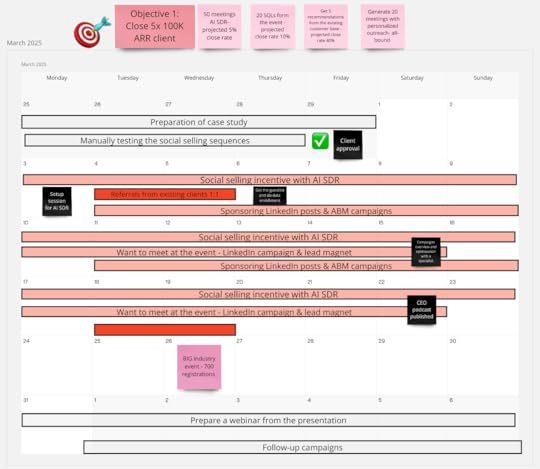 This is an example of the planning - get the access to all assets hereThe rule of 100: Gamification of tedious grunt work
This is an example of the planning - get the access to all assets hereThe rule of 100: Gamification of tedious grunt workNow, whenever I see activities such as “create LinkedIn content, educational content, start ABM…” I have to take a deep breath. I like speed, fast results, and outputs - but these activities sound like a lot of work with questionable ROI.
 This mindset will help you with grunt work in GTM. Prepared with Ognjen Bošković.
This mindset will help you with grunt work in GTM. Prepared with Ognjen Bošković.If I see that this work just has to be done because the audience is the best and - let’s be honest - we get good at things by doing them… I will commit to doing the work. Moreover, some GTM motions (predictable and scalable ways to acquire customers) require a lot of input before we can see some compound effects. For example, inbound requires lots of content production. In that case, it is a decision, not a chore. Or is it …?
You see, one of the most frustrating things for me is to work and see no results. I find so much joy and excitement in rapid feedback loops. But sometimes, the work is just daunting. You have to work, work, work, and work for months - and no one is there to clap for you and cheer you on.
This year, I took on what is called Alex Hormozi’s “rule of 100”. Every day, I have to do:
100 minutes of content creation
100 outbound emails
Invest $100 in ads or
Have 100 conversations
And every day I do it, I mark ✅ in my planner.
I know this reward sounds silly, but I sometimes manage to gamify myself - following Atomic Habits logic - that every day, I have to do 3 out of 5 habits I am trying to create:
Workout
Learn something new
Execute on the rule 100
Eat healthy
Write - create assets.
It works for me - hopefully, it will work for you too.
The hidden beauty of implementing this rule is that you commit and do it. I have slots for this on my calendar. While this work will never feel awesome to do and is rarely fun, I am building a critical mass of reps with feedback loops so that I can get “organic leads non-attributed to a specific marketing action” and build “brand awareness” - whatever that means.
Mindful guide to outsourcing: Don’t do it/Outsource/Do it really wellNow, the fun part: who will do this work?
Here are some realities before we dive deeper.
If you are:
A part of the bigger organization → Either there is a dedicated GTM team or, most probably, a PM or PMM will be assigned to do it with the help of internal colleagues and external agencies. Grunt work will more likely than not get outsourced.
SME → Once it is clear which GTM motion will work for you, get THE BEST GTM motion specialist with relevant industry experience you can afford. Practically, you want to “buy” someone who has done what you want to do for a company very similar to what you do.
Startup → In earlier stages, the founder is recommended to be hands-on with GTM. You are the one with the vision. If that is not an option, have a dedicated person early on, preferably as a co-founder, but do not offer equity to random advisors you don’t know will work well with you.
A founder on a shoestring budget → You will do the work - no excuses. But the good part is that you can learn and experiment fast.
There are more opinions than best practices here on what to outsource and what not.
Here is an example from my business. I would never outsource the following:
❌ Customer discovery - I need to talk with the users to feel their pain and get learnings. No transcripts or mood boards will ever make me feel what they go through.
❌ My core GTM motion (the one bringing in the most profit) - I have tried 7 times to make my life a bit easier, but it was always a giant fail. Now my mojo is to work with amazing experts to elevate my skillset in mission-critical areas.
❌I still do sales because the business is very tied to me as a founder. Sometimes, I sell through partners, but sooner than later, I would want to talk with a prospect.
These are the things I would outsource in an eyeblink:
✅ Editing and proofreading - I am more of an idea person, that is not my forte. It’s highly expert work that I am not the best at.
✅ Finance and legal - stuff that requires a lot of expertise but is not my core business capacity, and I am not a specialist in it.
✅ Bookkeeping and travel arrangements - relatively low added-value tasks that can be executed by trusted people but not necessarily top experts
In 2025, I am learning more about simplifying the business, investing more in automation and exploring the capacities of AI. But in general, I think of this like this: am I buying back my time or accelerating learnings:

This is very hard for me to do. I am still learning.
As a self-made professional, the mindset of “if you want to do it right - do it yourself” got me far.
But it will not get me to an entirely new level.
Slowly but surely, I am trying to let go as a founder. And I am lucky to work with Anže here, who is MUCH better at managing processes than I am, but one thing I can do better than almost anyone else is ….
Do whatever is mission-critical! 🎯
Repeat these mantras after me:
“You can do anything, but you cannot do everything.”
“Is it mission-critical?”
“Focus = saying no.”
“You are always operating with limited resources. What separates winners from losers is how we prioritize them to reach the objectives.”
GTM will always be hard, chaotic, ambiguous, stressful, and full of unknowns.
What makes it hard is also what makes it so rewarding.
If it was easy, everyone could do it.
Entrepreneurs are only 7.4% of the world's population.
Among all of us, 95% will fail to win the early majority of the market (cross the chasm)
72% of companies fail due to go-to-market mistakes, not bad products.
We chose hard.
Hard can bring disproportionate rewards.
I also think it shapes incredible humans.
But don’t make it harder than it already is. Focus on the tasks and projects that will make the biggest impact on your business. Use a powerful weapon of saying NO more often. And most importantly: do not give up.
There are great days - there are terrible days.
Your life in GTM will account for some of the most amazing stories of your career.
True hero stories where you win against all odds.
That makes legends ✌️
Thanks so much for reading - but in the spirit of this article:
It doesn’t matter how many articles you read. How you change your behavior (implement this knowledge) makes all the difference.
What is one key takeaway from this article for you?
What can you take from this article and apply to your business today?
If you are brave enough to commit in the comments, I’ll salute you!
But no matter what - let’s break the analysis paralysis cycle and get mission-critical work done!
My new product: GTM Checklist with AI Prompts ✨One week, I launched the Go-to-Market Checklist with AI Prompts. It consists of 100+ tasks to get new customers for tech products in under 14 days.
It is an upgrade of my best-selling step-by-step checklist that will get you from launch planning to scaling profitably and faster - now with the help of AI.




